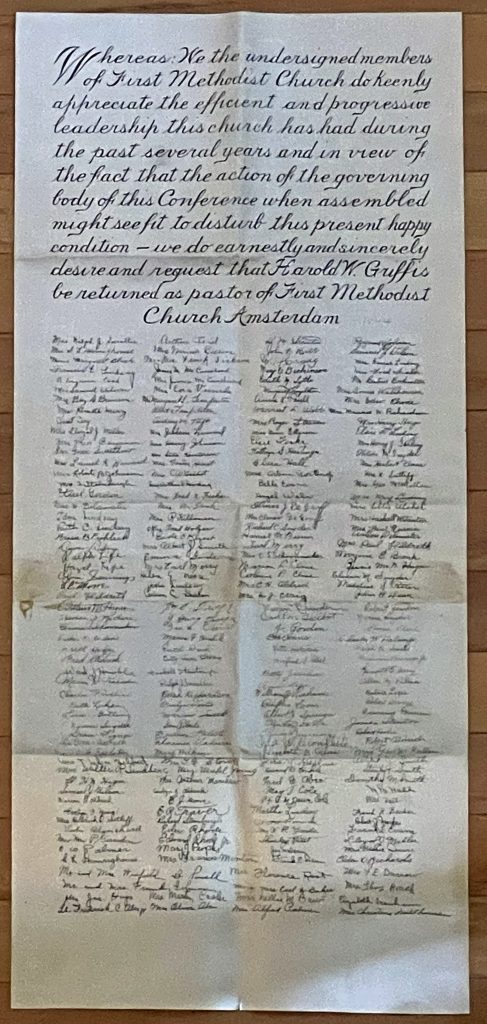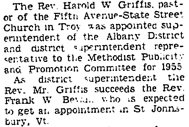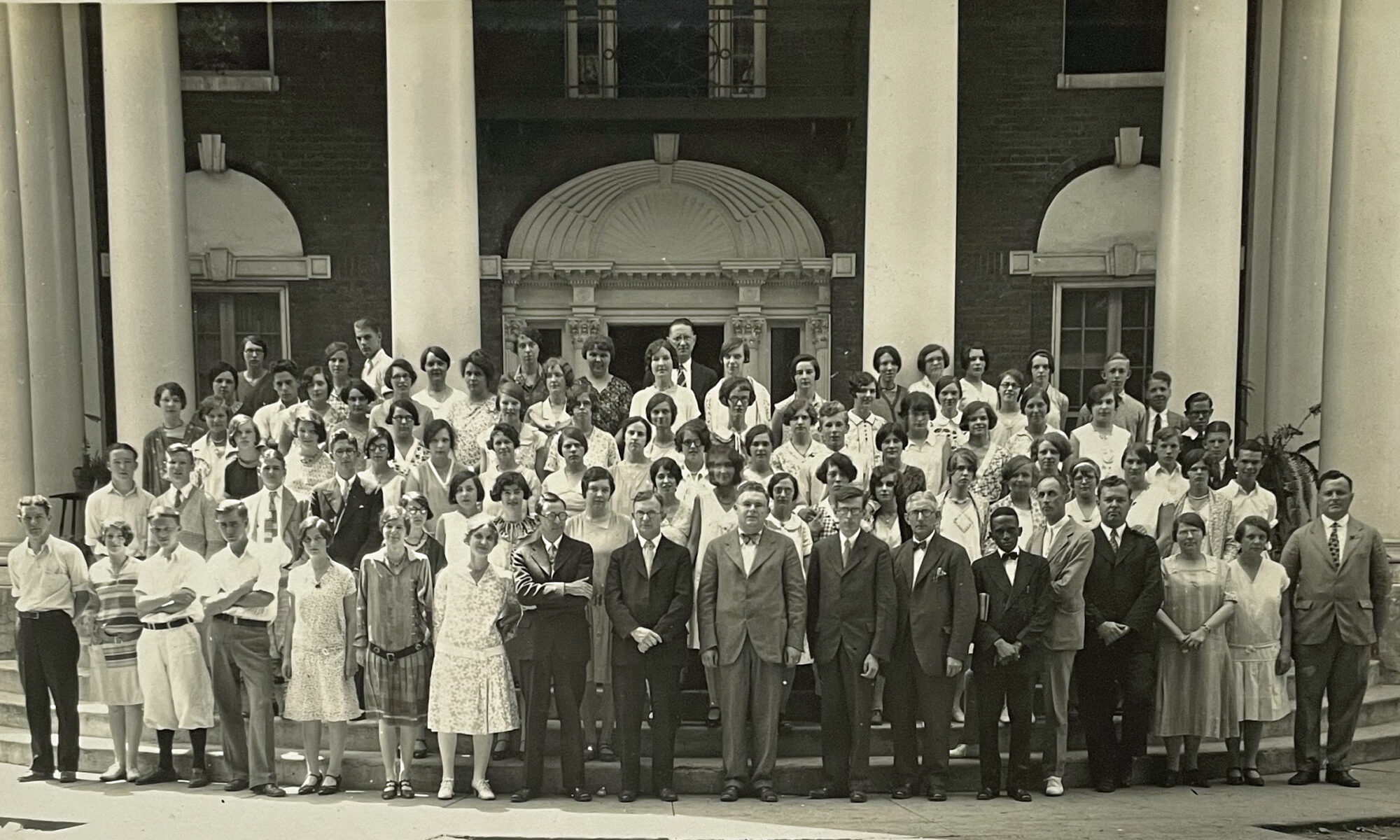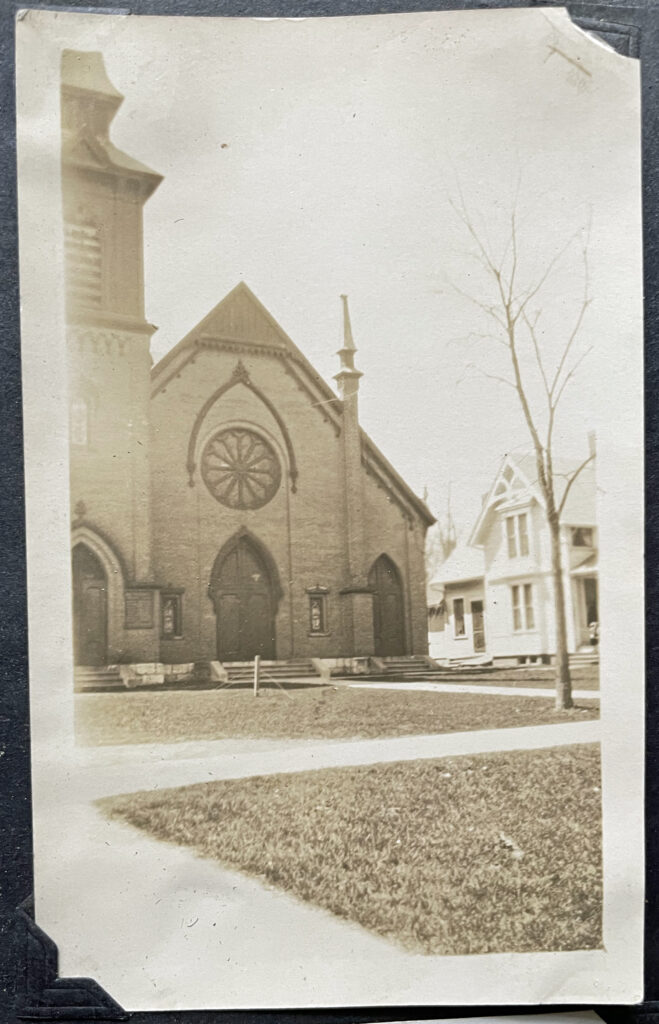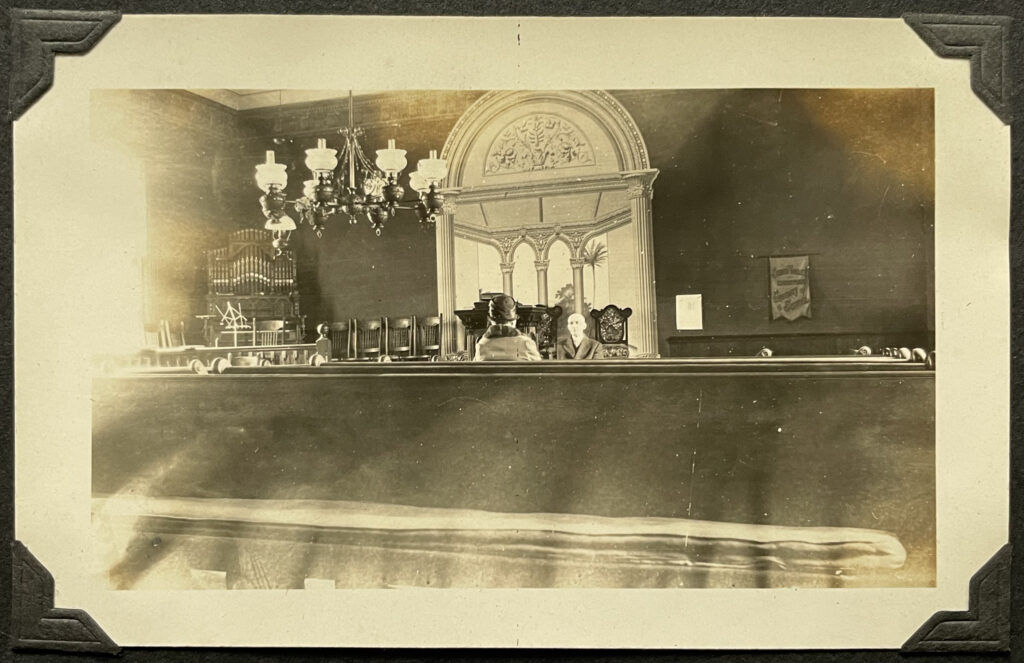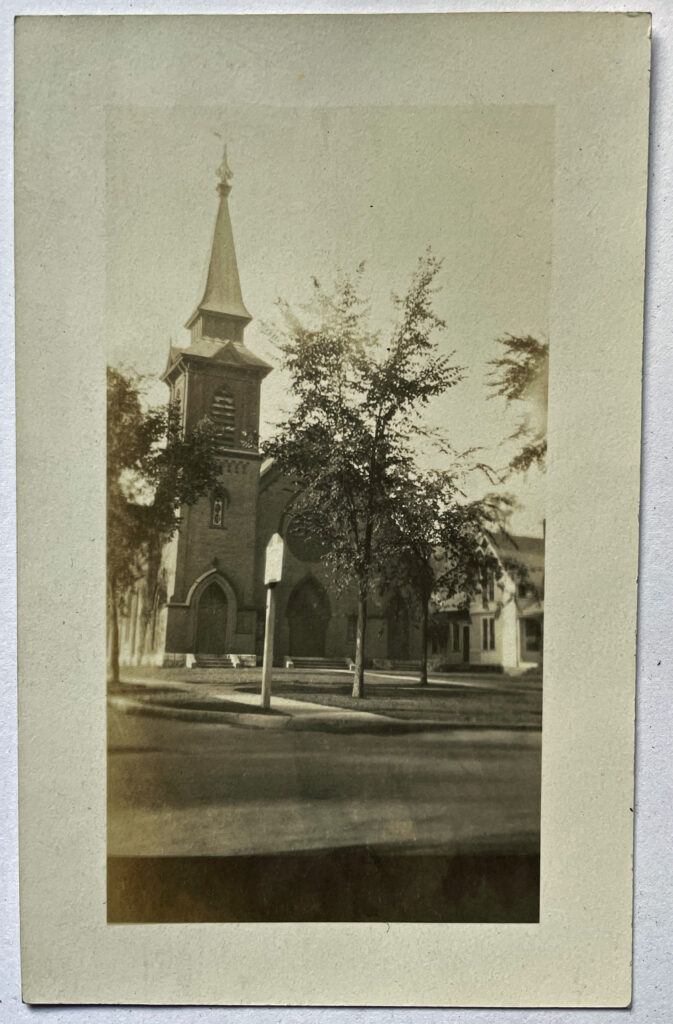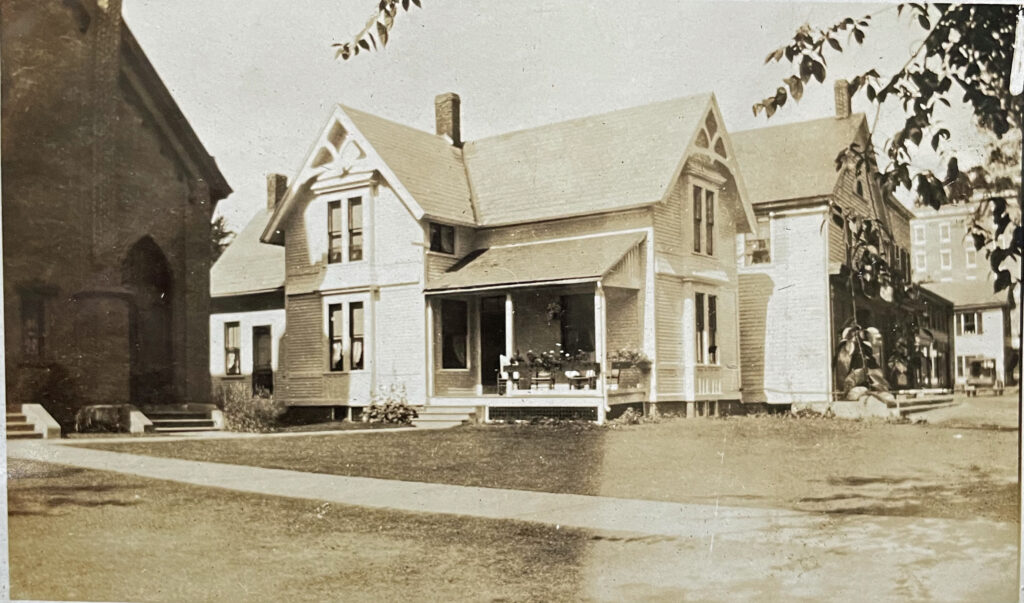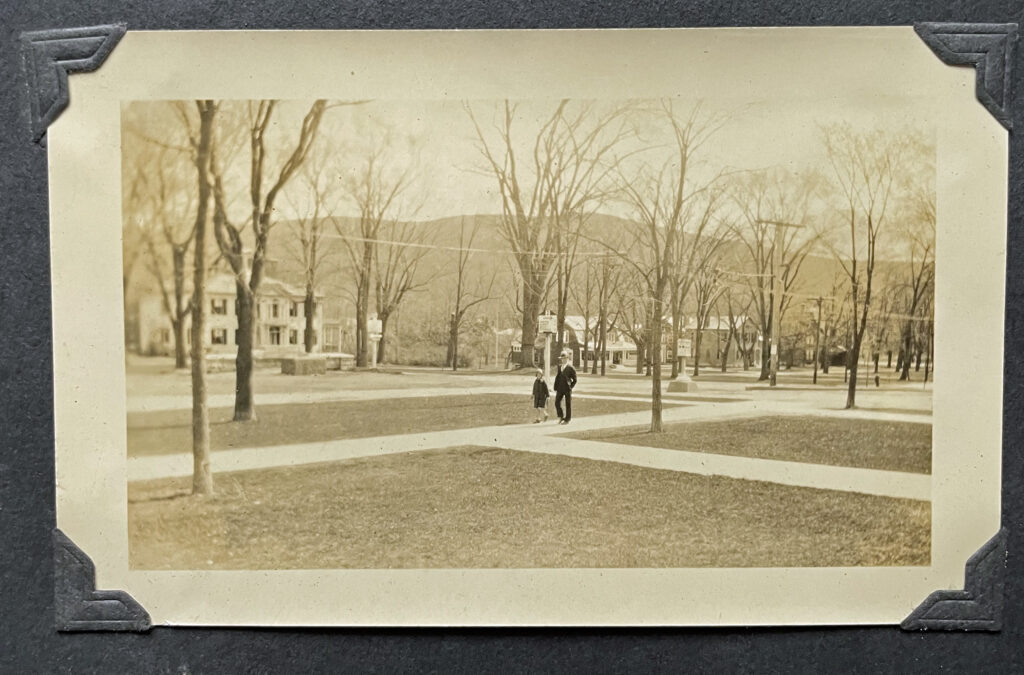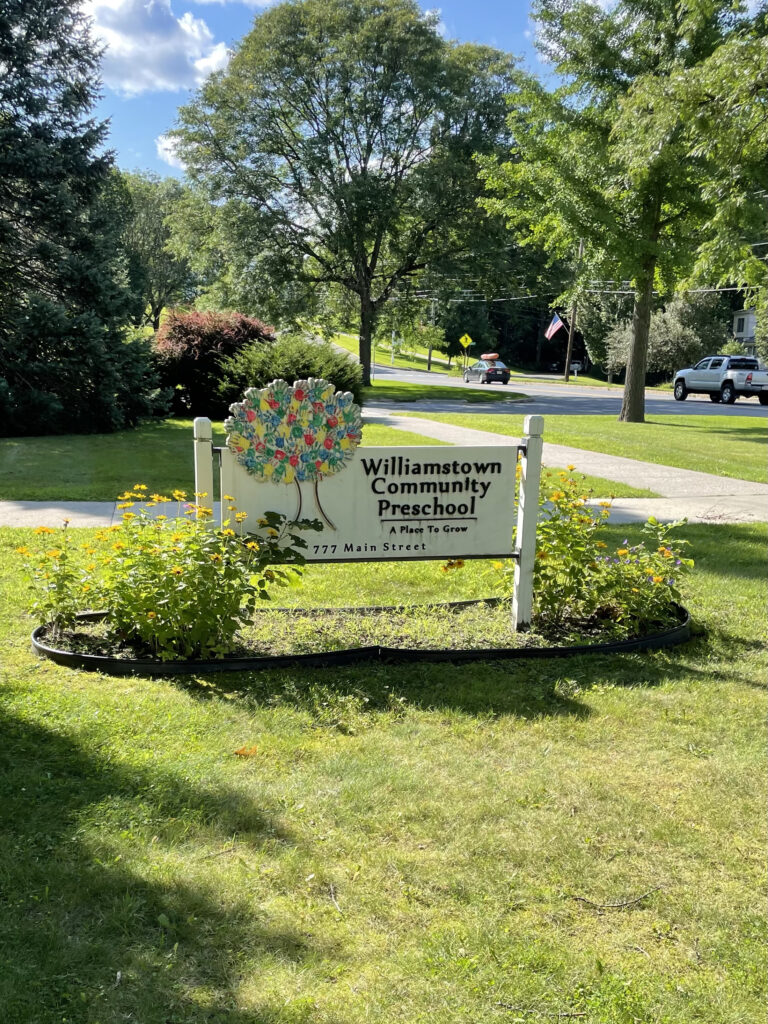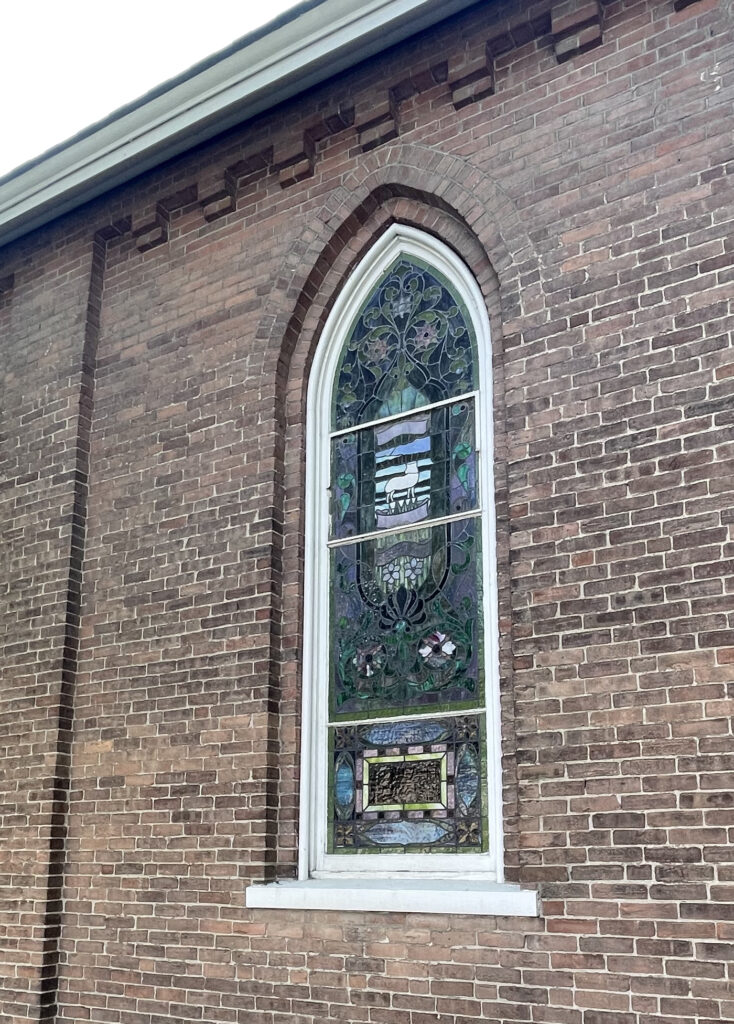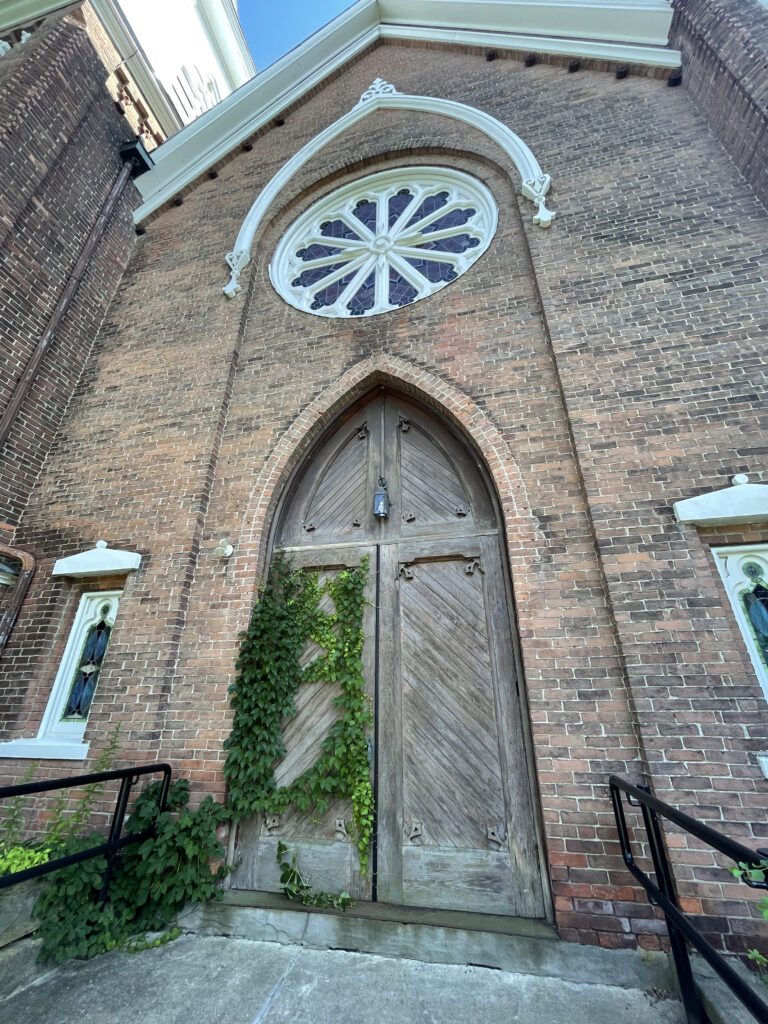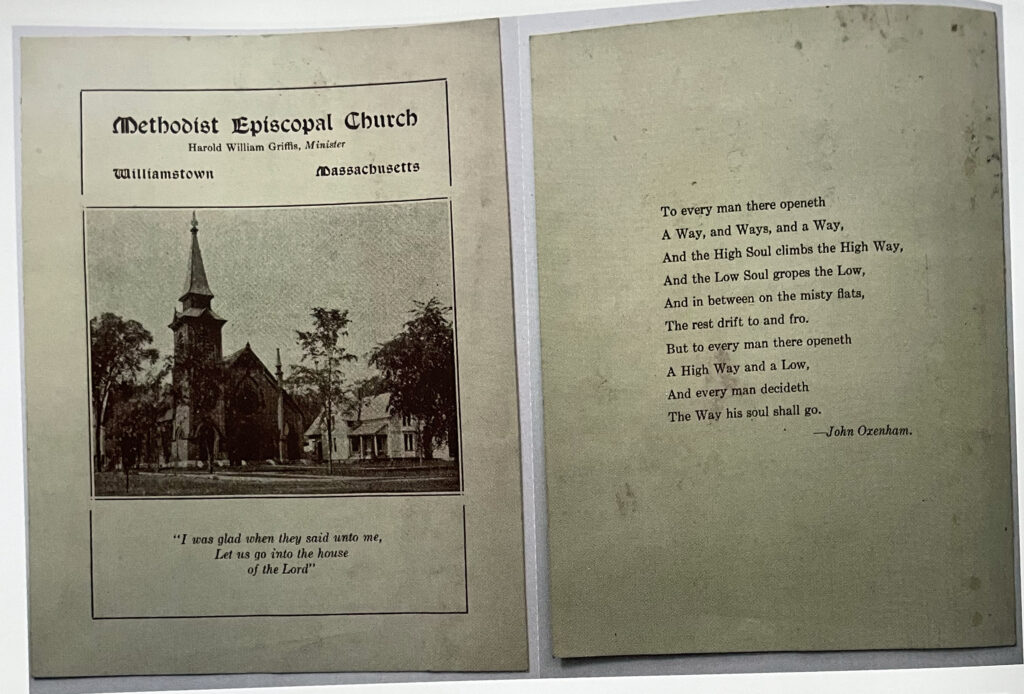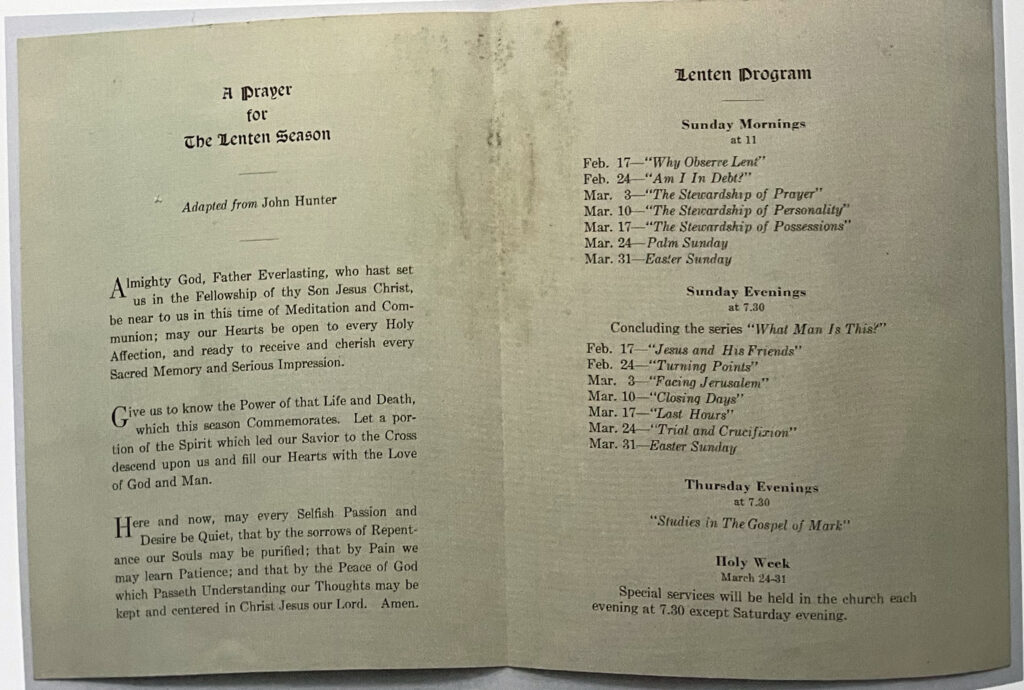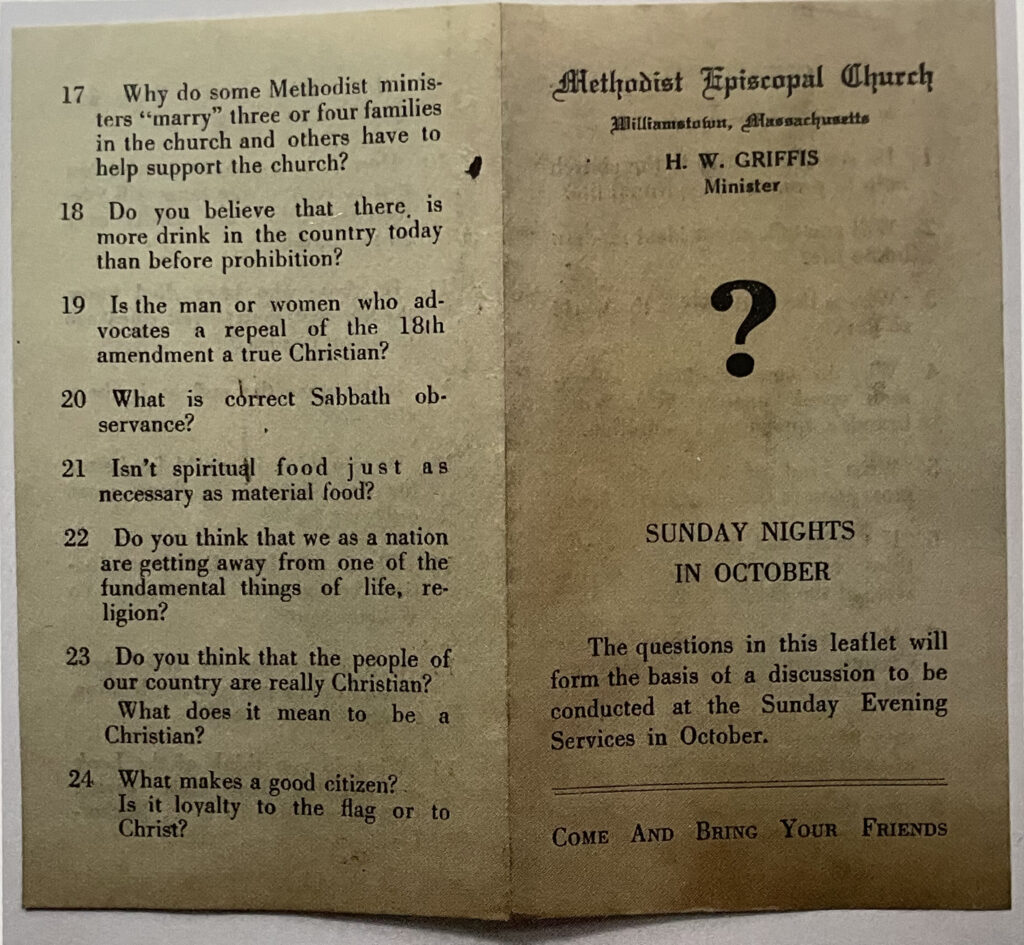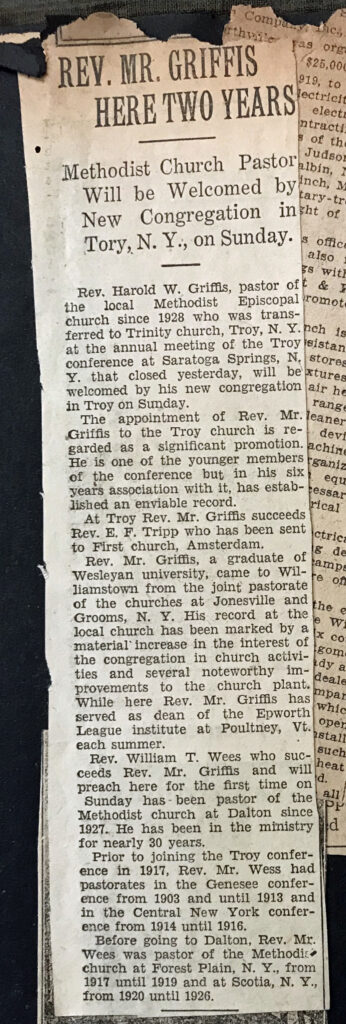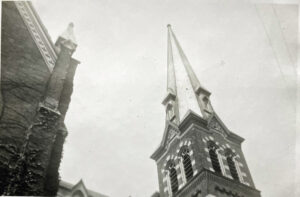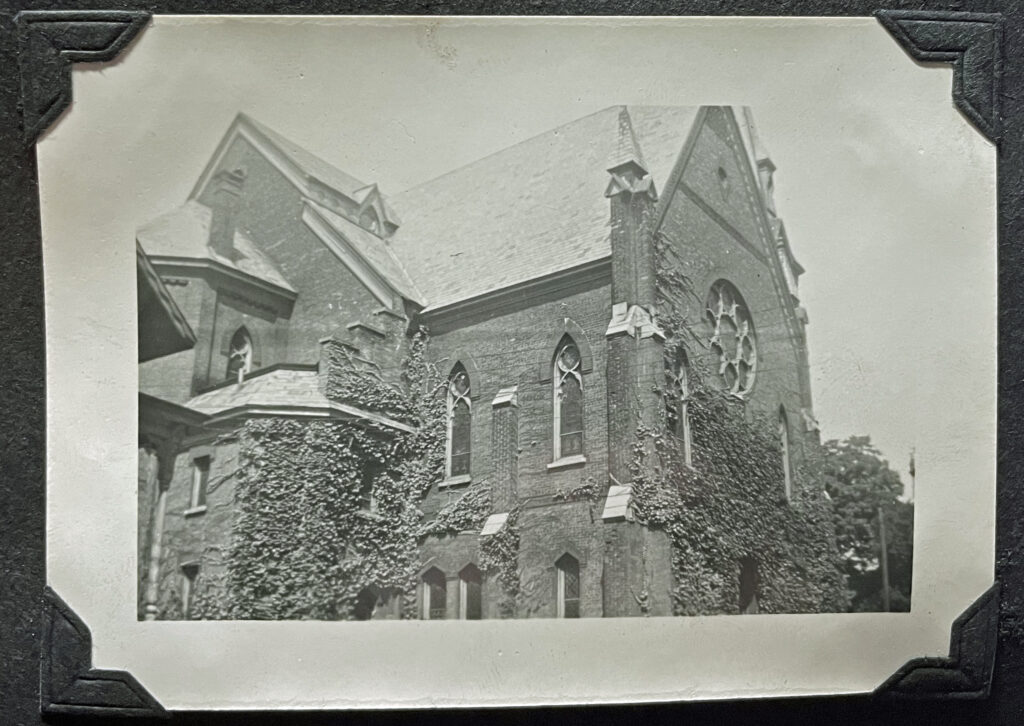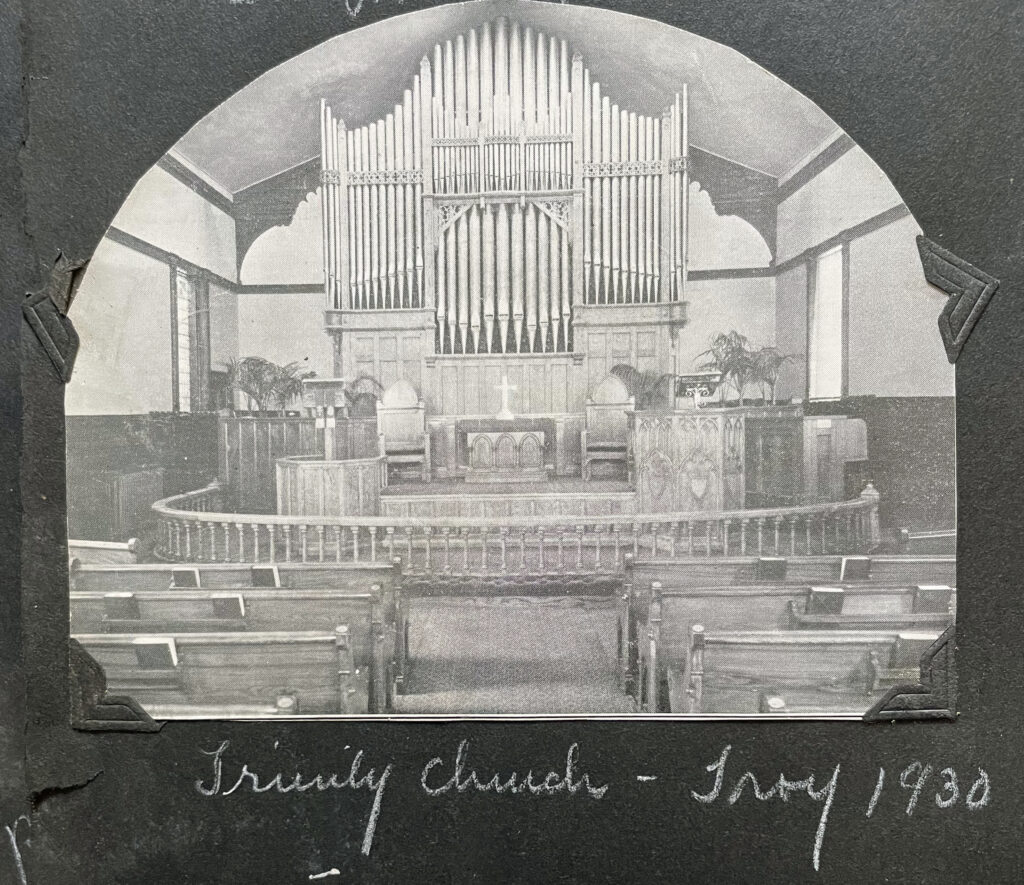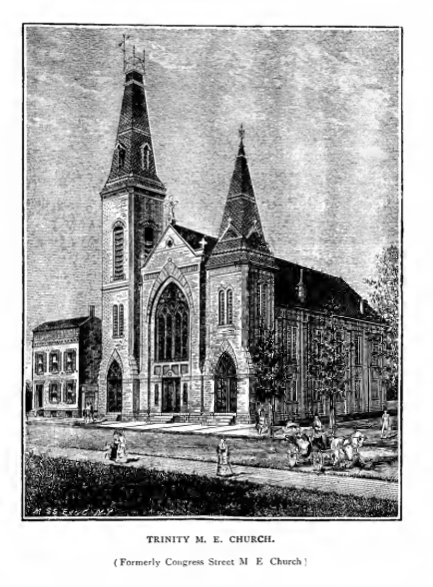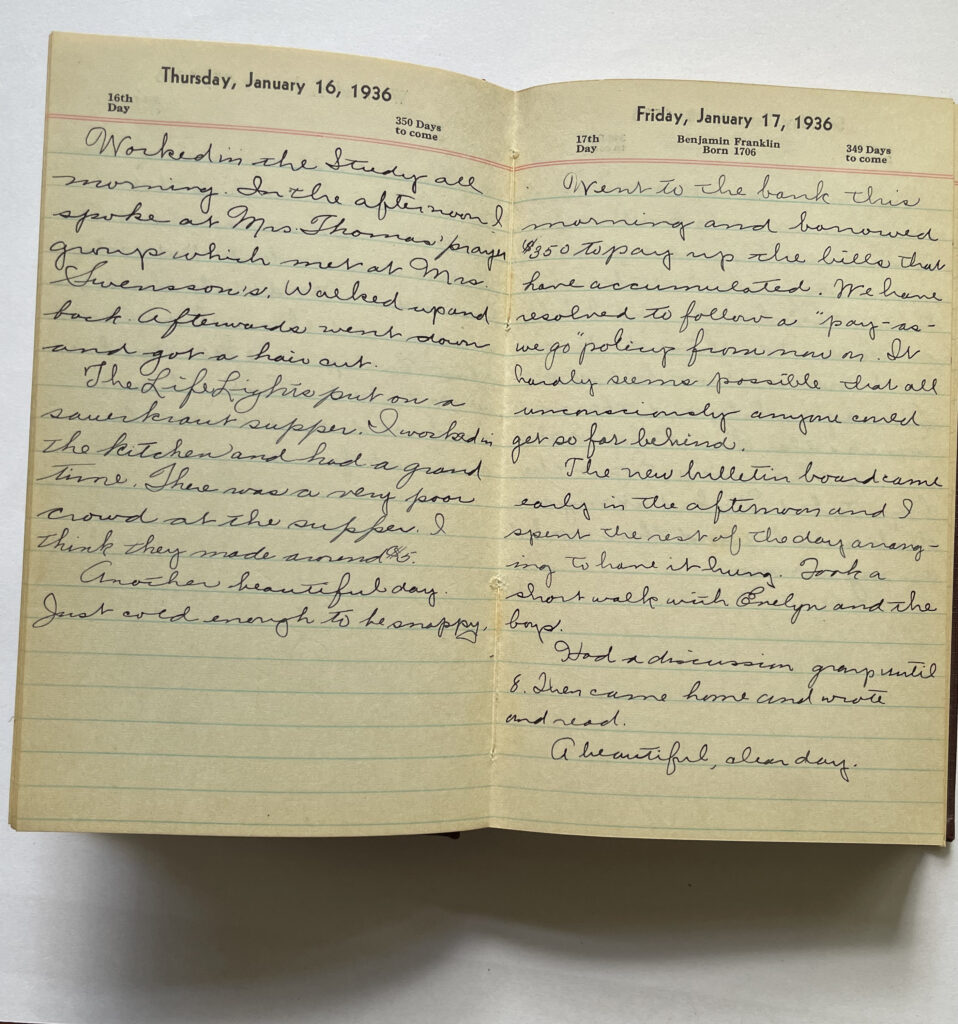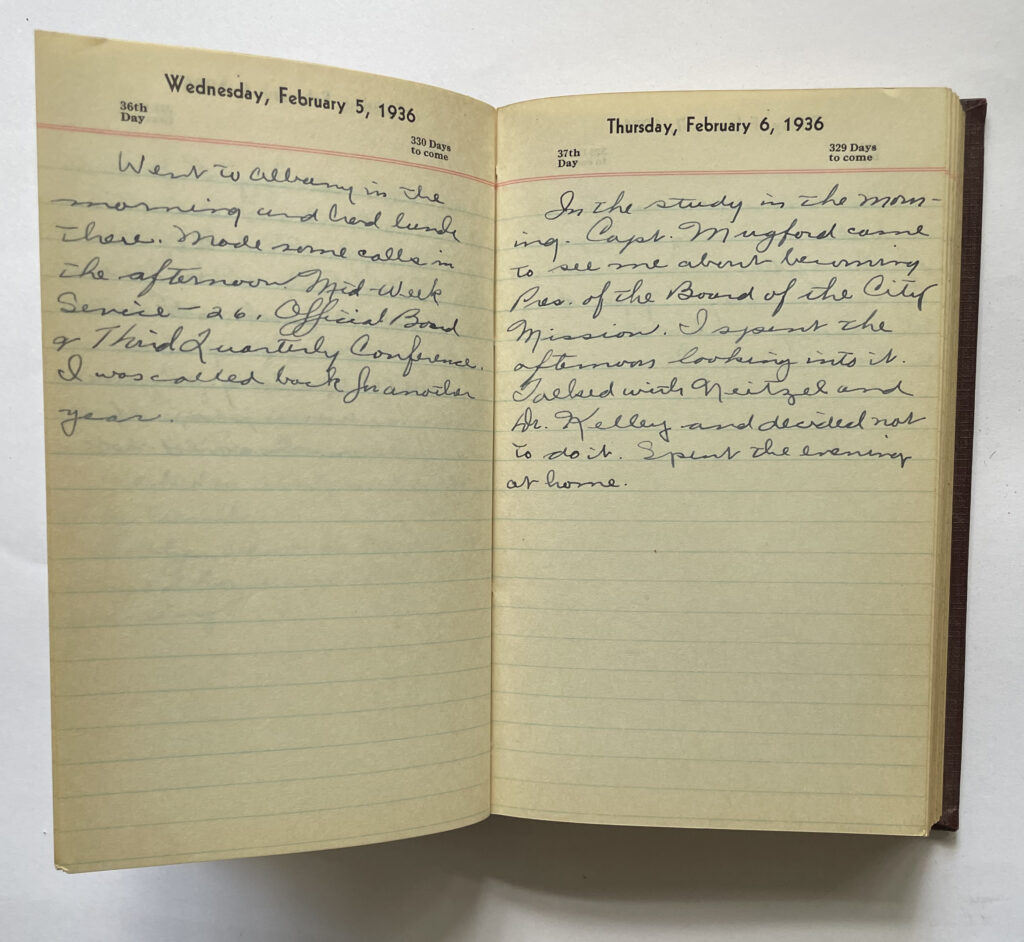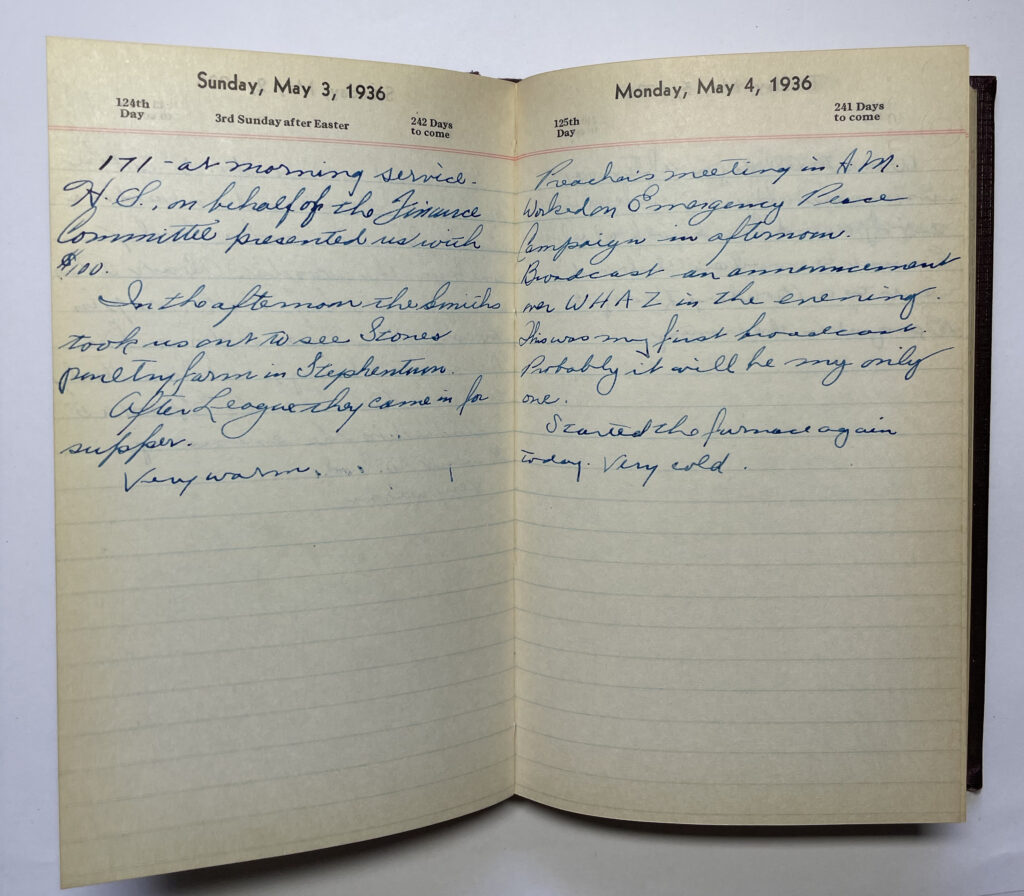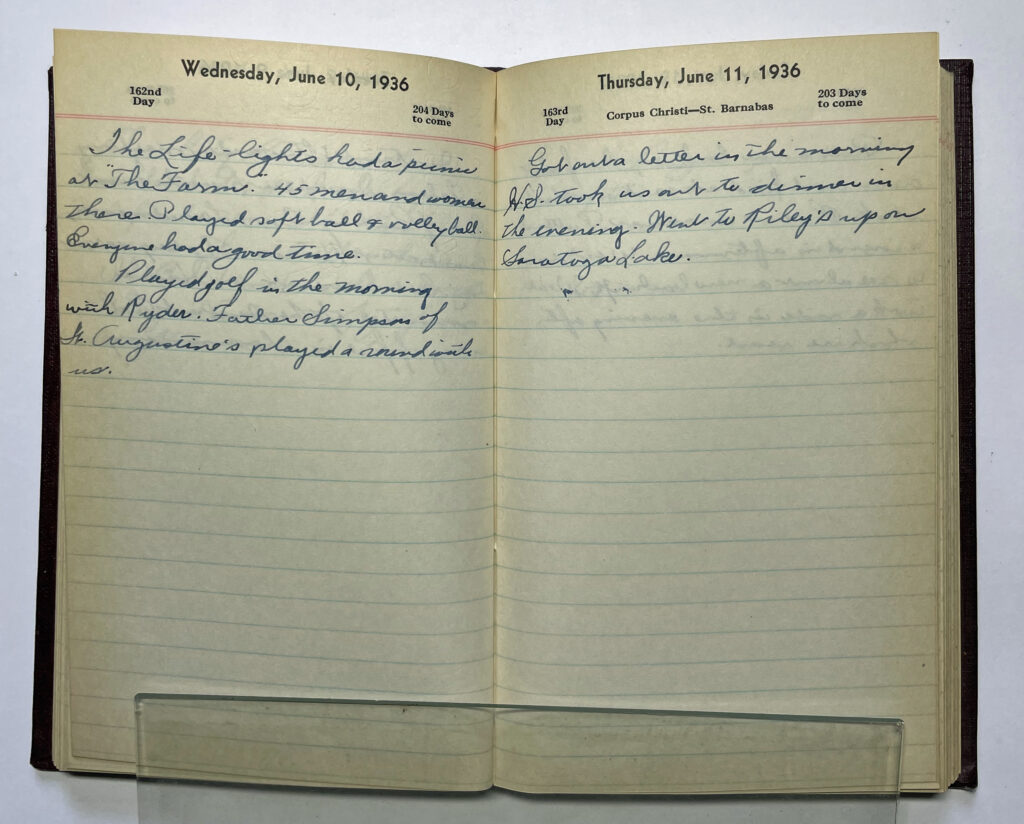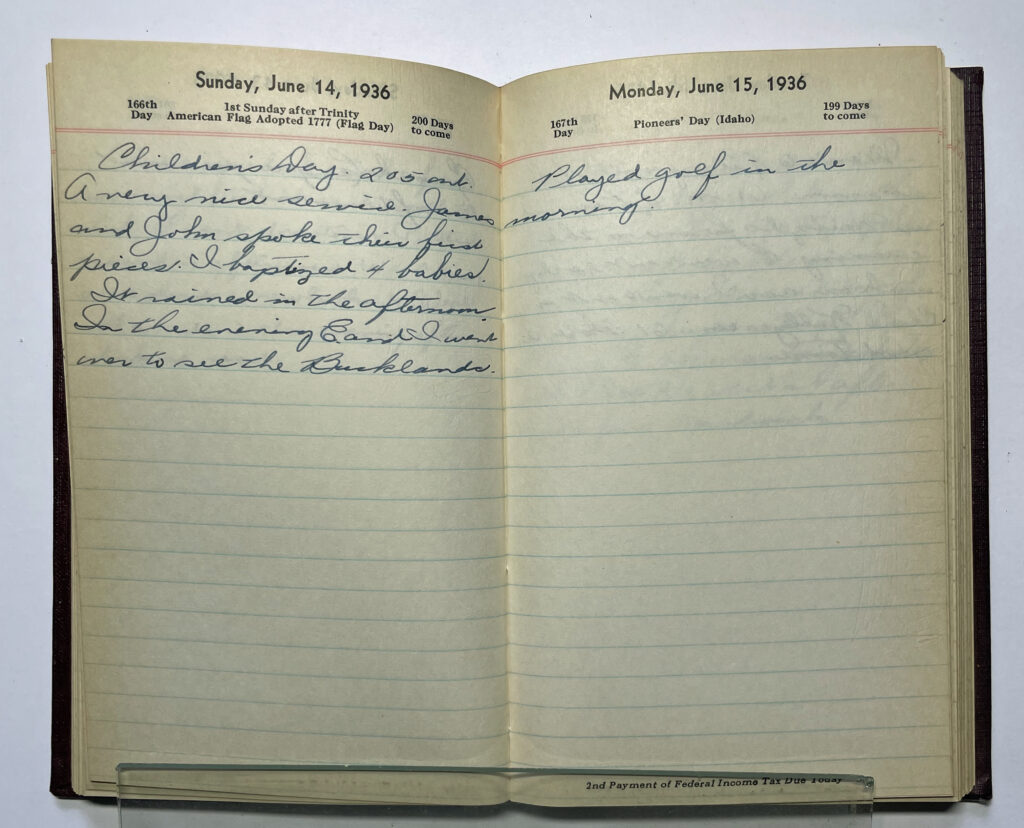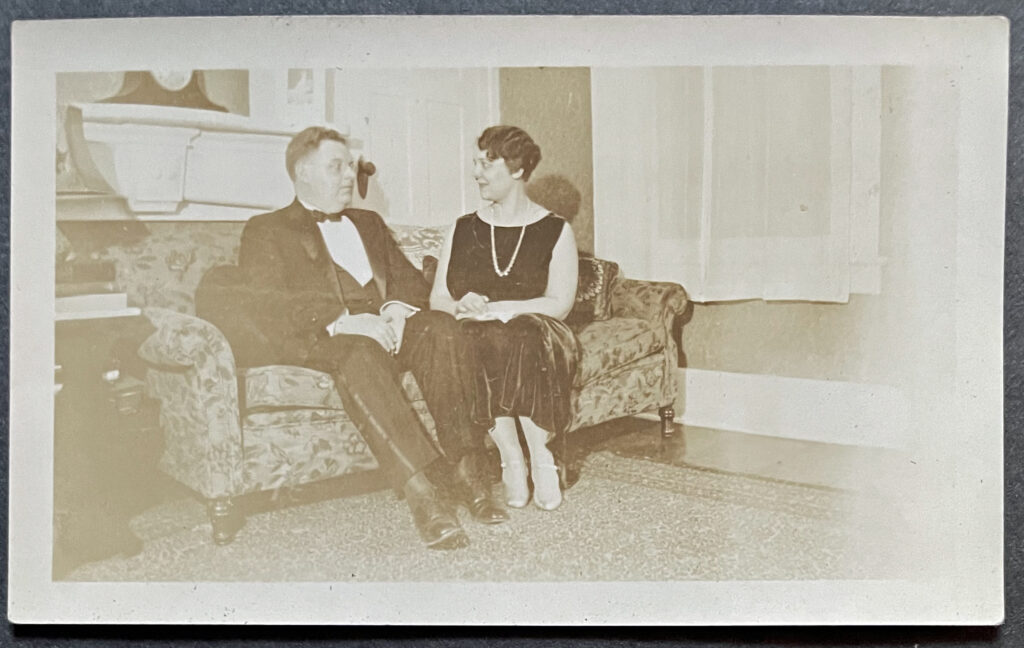This is the third part of the story of Harold Griffis as a Methodist minister and pastor.
The following reflects the major milestones in his career within the Methodist Episcopal church. The first part of the story covered Harod’s career up through his pastoral duties with the Jonesville Methodist Episcopal (M.E.) Church and Groom’s M.E. Church from 1925 – 1928. Part III of the story resumes with his career in 1938 in Amsterdam, New York
| Year | Position |
| 1925 | Pastor of Jonesville Methodist Episcopal (M.E.) Church and Groom’s M.E. Church, NY |
| 1928 | Pastor at Methodist M.E. Church in Williamstown, MA |
| 1930 | Pastor at Trinity Church, Troy, NY |
| 1938 | Pastor at the First Methodist Church, Amsterdam, NY |
| 1940 | In addition to First Methodist Church, pastor of East Main M.E. Church, Amsterdam |
| 1946 | District Superintendent of Troy District |
| 1948 | Pastor at 5th Avenue & State Street Methodist Church, Troy, NY |
| 1954 | District Superintendent of Albany District |
| 1958 – 1961 | Pastor at Trinity Methodist Church, Albany, NY |
“A forceful and eloquent speaker with the ability to clothe spiritual truths in the cloak of humor…”
– The Glens Falls Times, Jan 12, 1955, Page 14
The quote in the title of part II of this story is from a newspaper article in 1955 that captures one of the unique qualities Harold Griffis had as a speake. Harold was adept at translating lofty, spiritual concepts into pragmatic terms and everyday experiences. He had a great sense of humor and usually incorporated his wit in his talks. The speech was given at a local Kiwanis Club meeting when Harold was a superintendent of the Albany District of the Troy Conference of the Methodist Church. Harold provided a message on the importance of individual responsibility. He stated that the most important thing in the world is “what I deliver – not our statement of high ideals”.
1938 – 1946: First Methodist Church and East Main M.E. Church, Amsterdam, New York
Harold was appointed to serve the First Methodist Church in Amsterdam in 1938. The parsonage was next door to the church and across from the Amsterdam junior high school. Two years later, as indicated in the April 1, 1940 newspaper article below, Harold was also appointed to serve as pastor to the East Main M.E. church in Amsterdam.
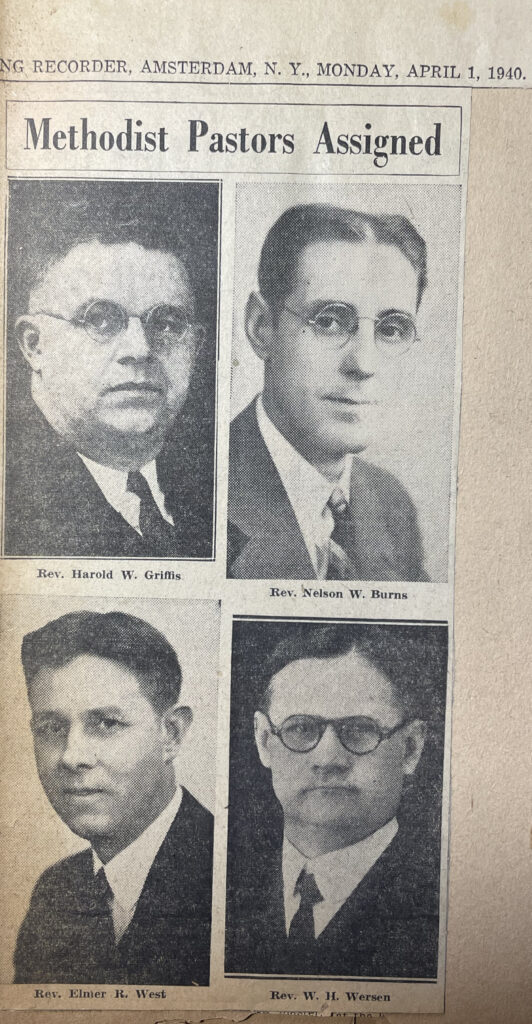
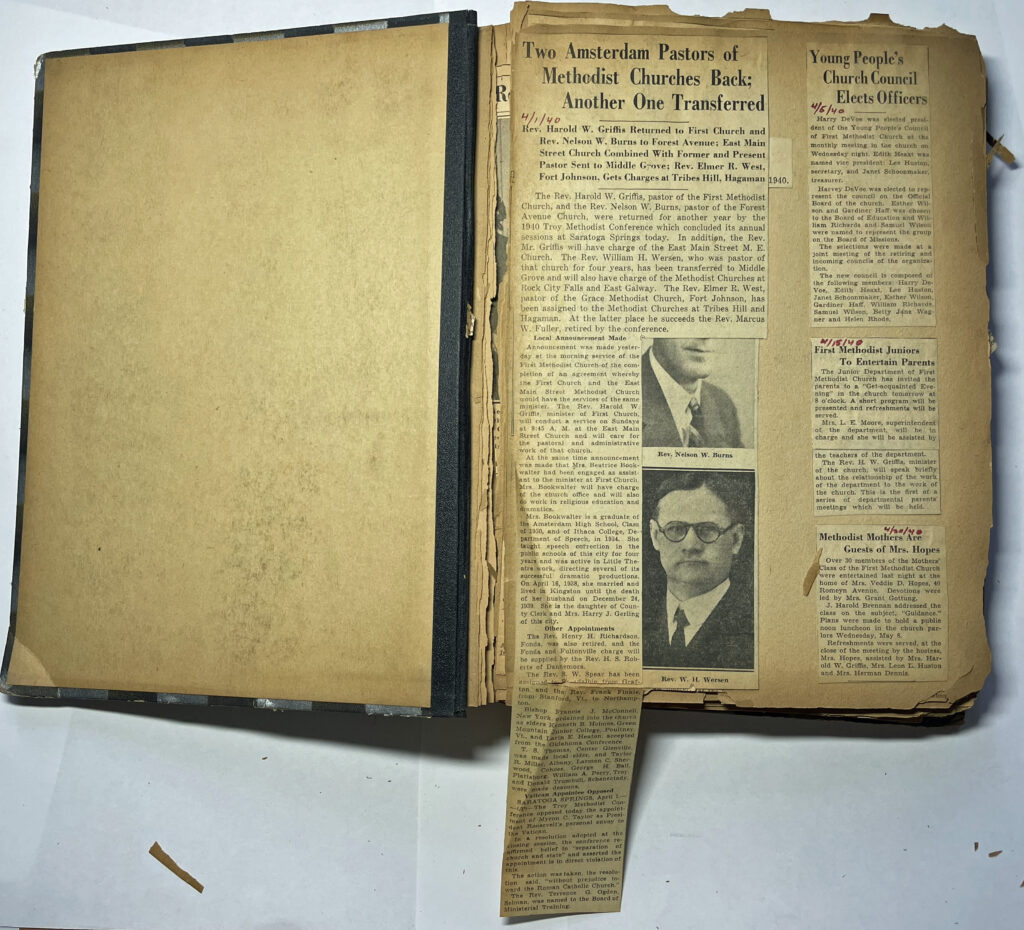
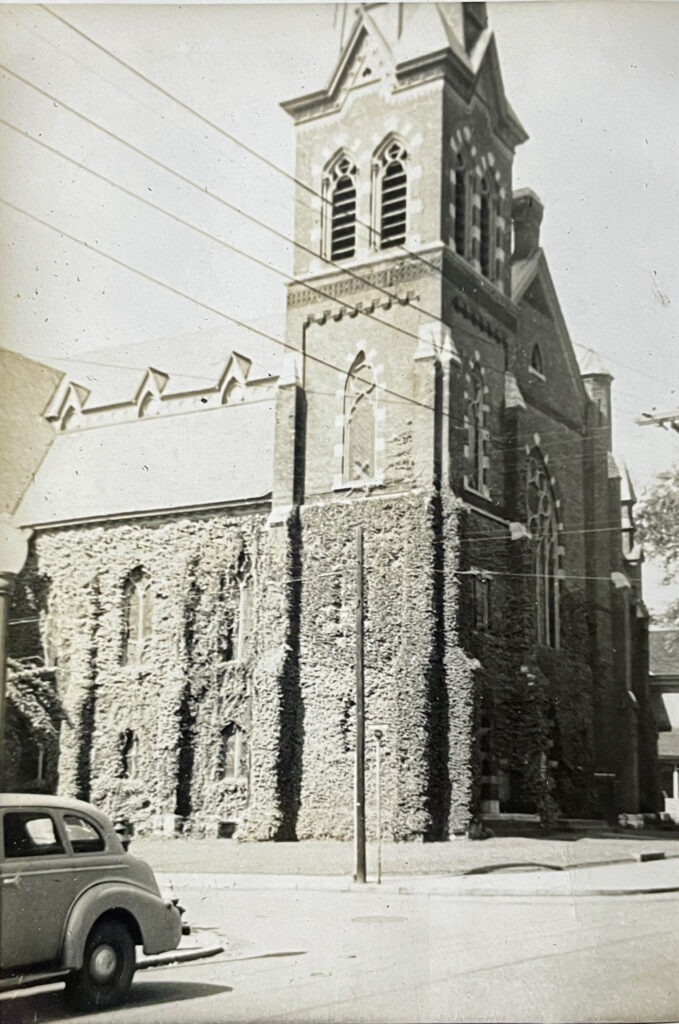
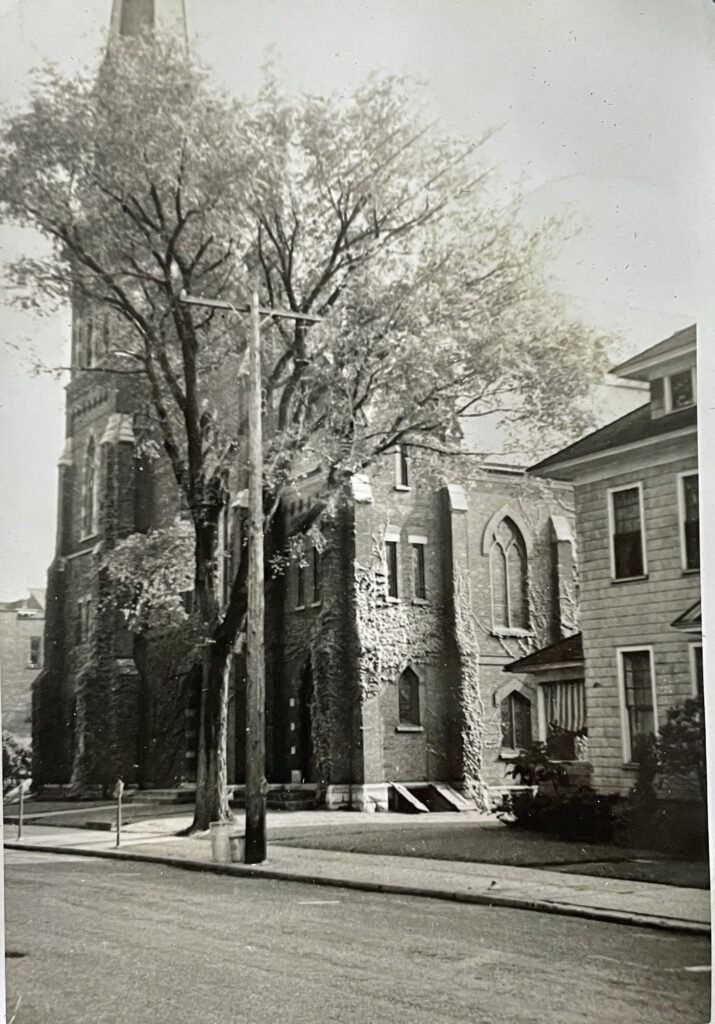
The following is a church program when Harold was pastor of the First Methodist Church.

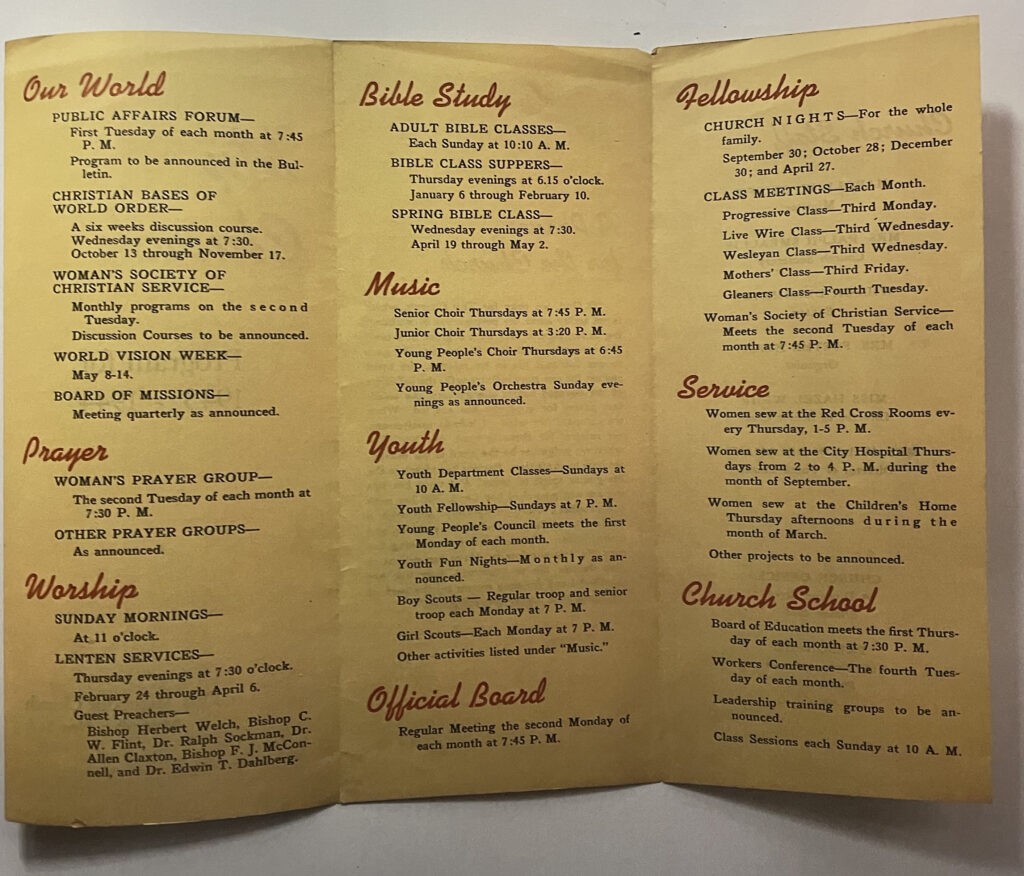
The following is a newspaper article by Hugh P. Donlon, a reporter and historian from Amsterdam. He started his ‘Main Street’ column in 1931. [1] This newspaper scrapbook article from 1938 captures Harold Griffis’ two worlds, the spiritual and the mundane world of dealing with earthly problems. The original article was kept by James D. Griffis.
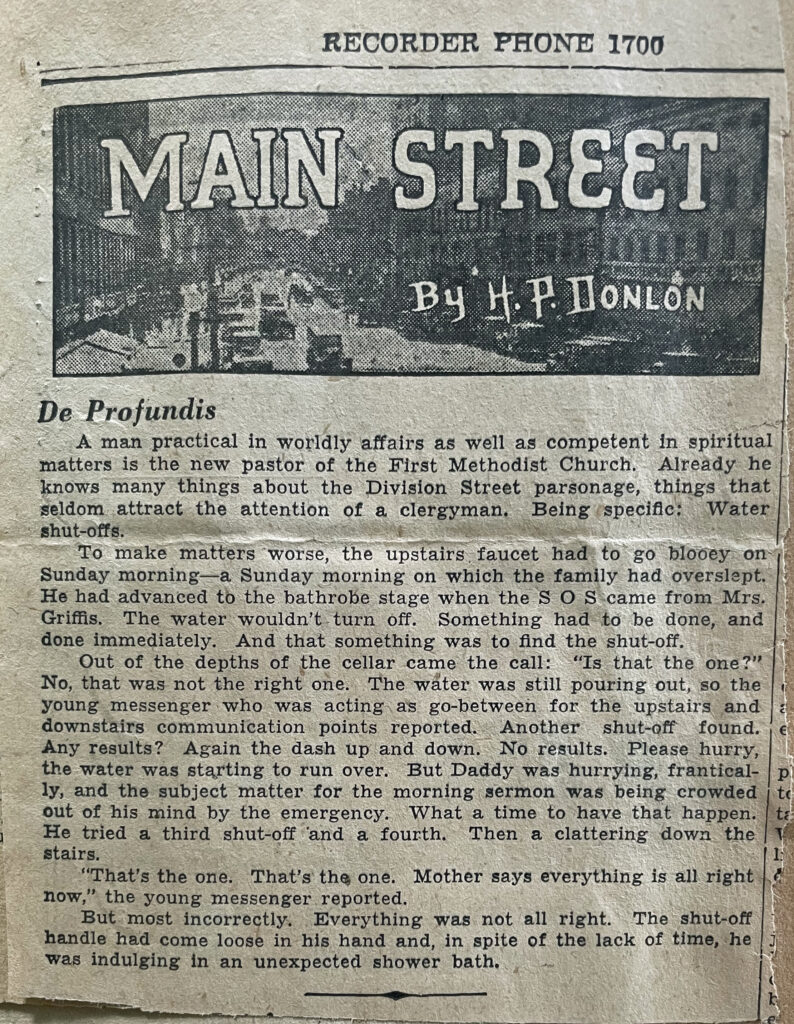

A few of Harold and Evelyns’ friends were part of a small circle affectionately called, ‘June Bugs’ since the couples were all married in June. The following photograph was taken by Harold. Back row: Ernest Tripp, Frank Bevan, Cassius Miller; front row: Frances Bevan, Louella Miller, Evelyn Griffis, Margaret Tripp. Ernest, Frank and Cassius were methodist ministers.
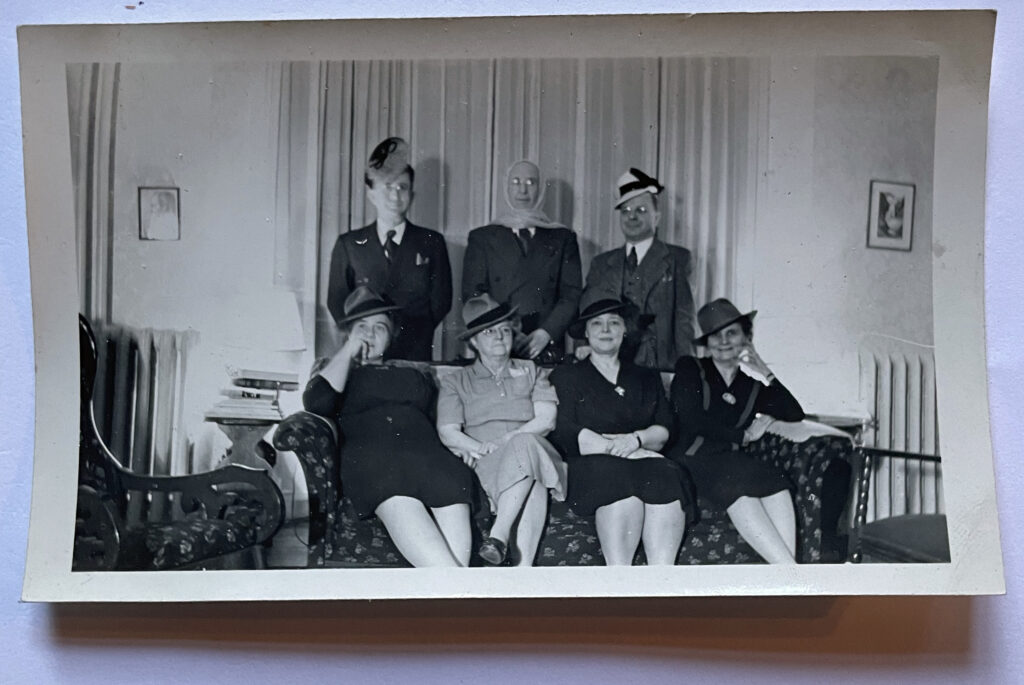
Harold Griffis, second from right, with young parishioners in Amsterdam, NY. His son James Dutcher Griffis is second to the left in the back row.
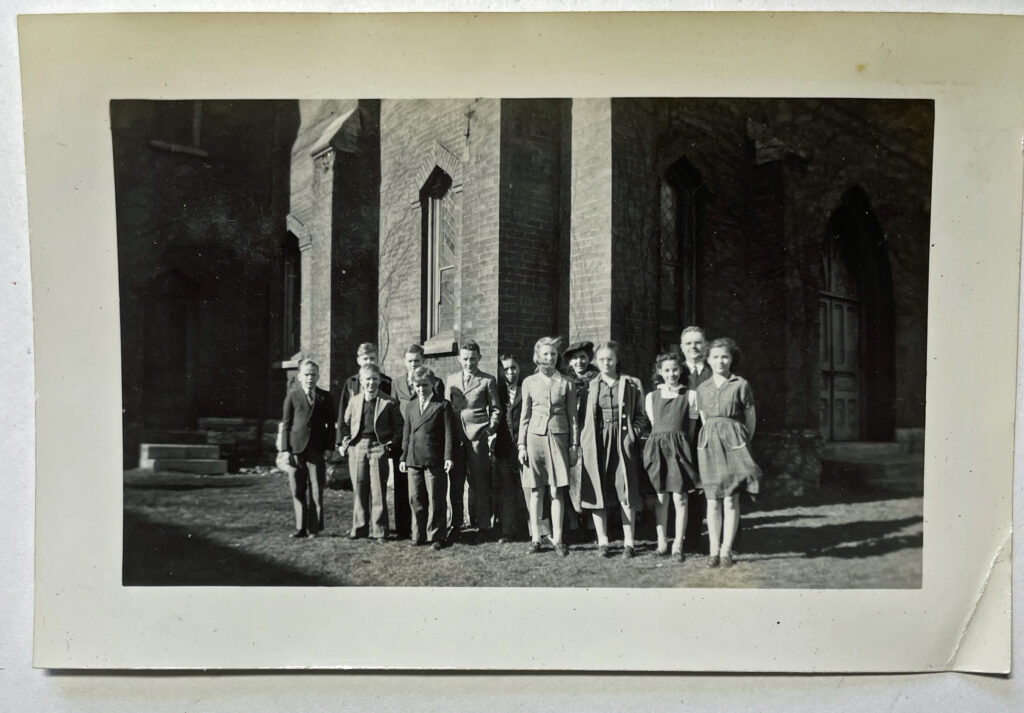
Evelyn Griffis, fourth from the right, with young parishioners. James Dutcher Griffis is second to the left.
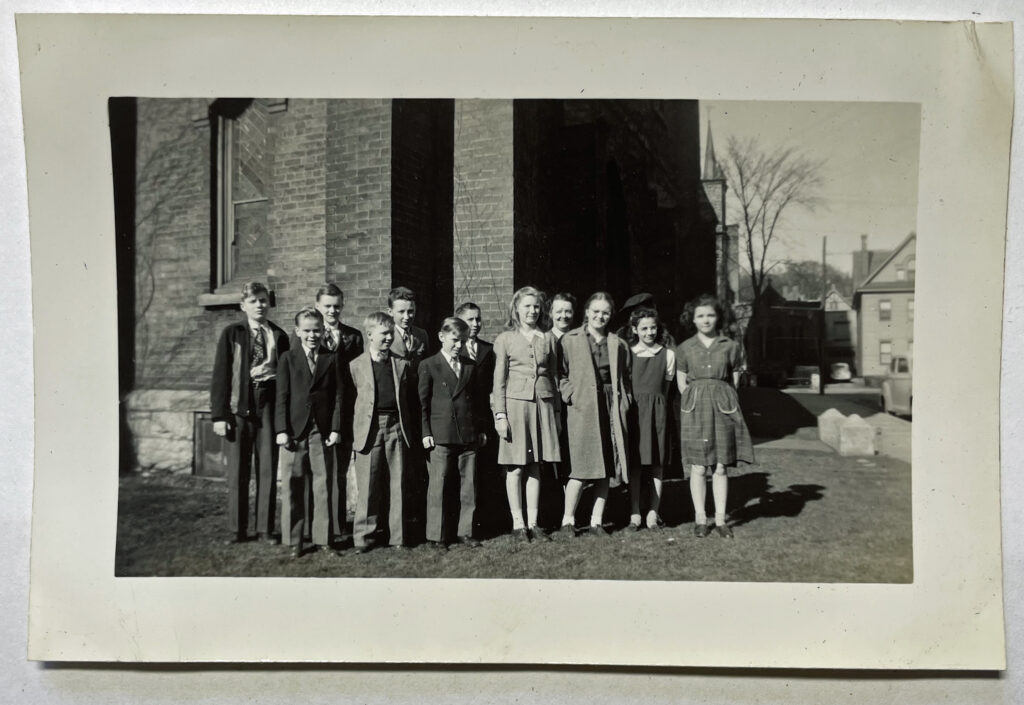
Harold Griffis, far right, and his sons James D., to his left, and John H., third from the left back row, circa 1946.

Harold apparently had significant impact on the church members of the First Methodist Church in Amsterdam. When the Troy District governing body of the church decided to reassign Harold to another position, 224 members of the church signed a petition that was presented on a paper measured 57 inches by 17 inches.
“Whereas: We the undersigned members of First Methodist Church do keenly appreciate the efficient and progressive leadership this church has had during the past several years and in view of the fact that the action of the governing body of this Conference when assembled might see fit to disturb this present happy condition – we do earnestly and sincerely desire and request that Harold W. Griffis be returned as pastor of First Methodist Church of Amsterdam.”
1948 – 1954: 5th Avenue & State Street Methodist Church, Troy NY
Harold’s next assignment was the pastor duties at the 5th Avenue and State Street Methodist Church in Troy, New York. The pastoral relations committee of the church requested Bishop Newell to appoint Harold as their pastor. As Evelyn recounted in a biographical letter, Harold reluctantly agreed to the reassignment.
At the Annual Troy Conference Harold was appointed District Superintendent of the Troy District. As district lines had been changed, there was no parsonage. The family had to buy a house. Harold and Evelyn found a house at 1631 Tibbetts Avenue in Troy, New York.
The church had a long history. The Methodists of State Street were outgrowing their second church building that was built in 1827. The State Street Methodists embarked on a new building campaign. In what Joseph Hillman named the “Last Church” for the Troy Methodists, a church of gigantic proportions was designed and constructed. It included seating for 900. The gothic structure was completed in March 1871. The 175 foot high spire towered the Troy skyline. The building was constructed of blue limestone. [2]
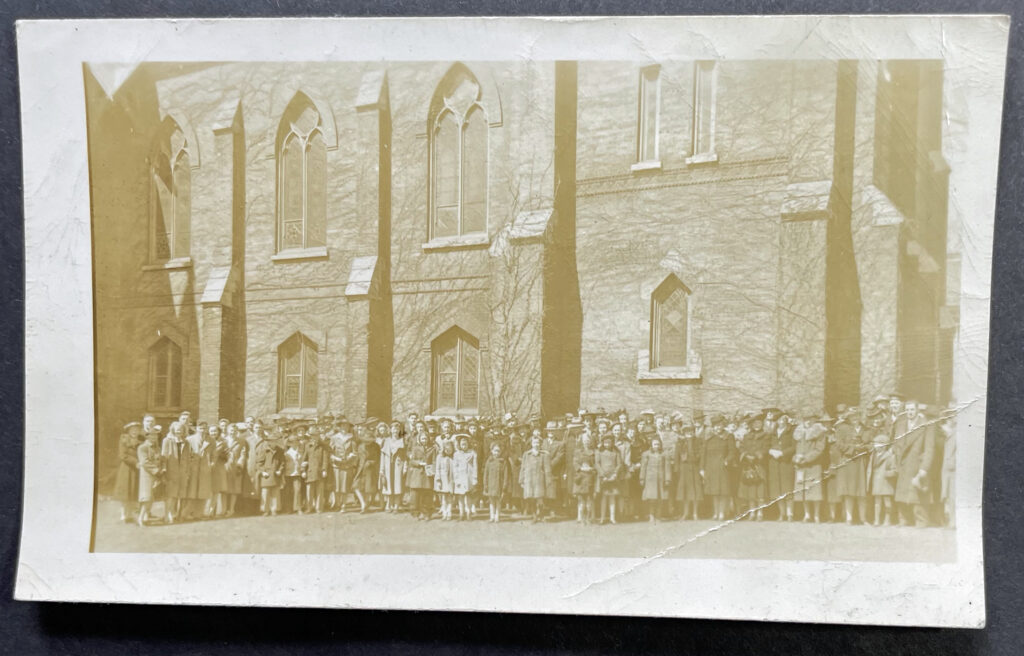
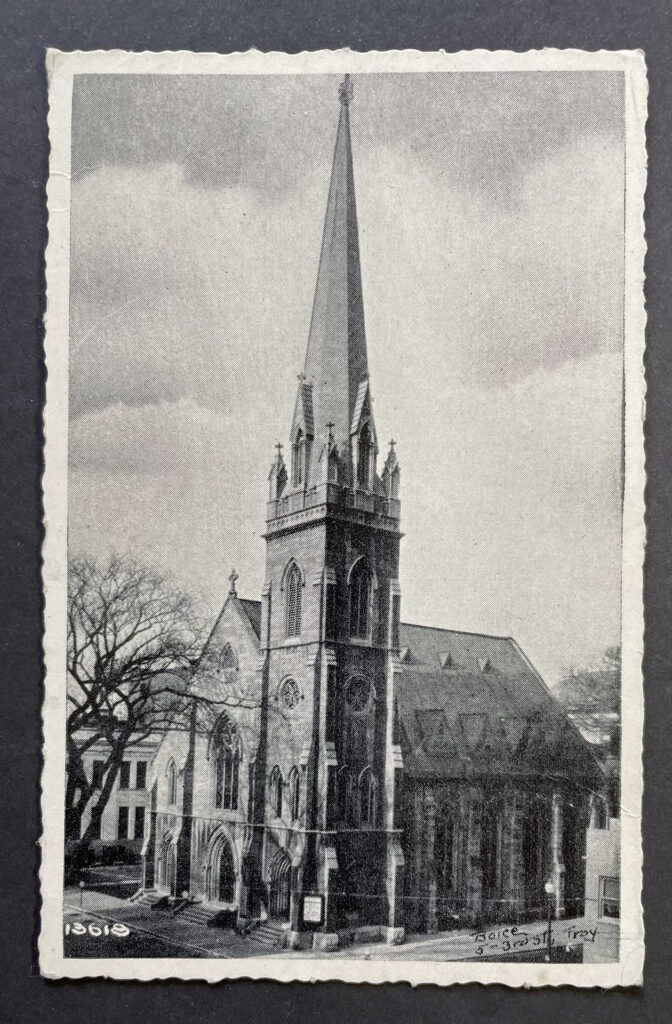
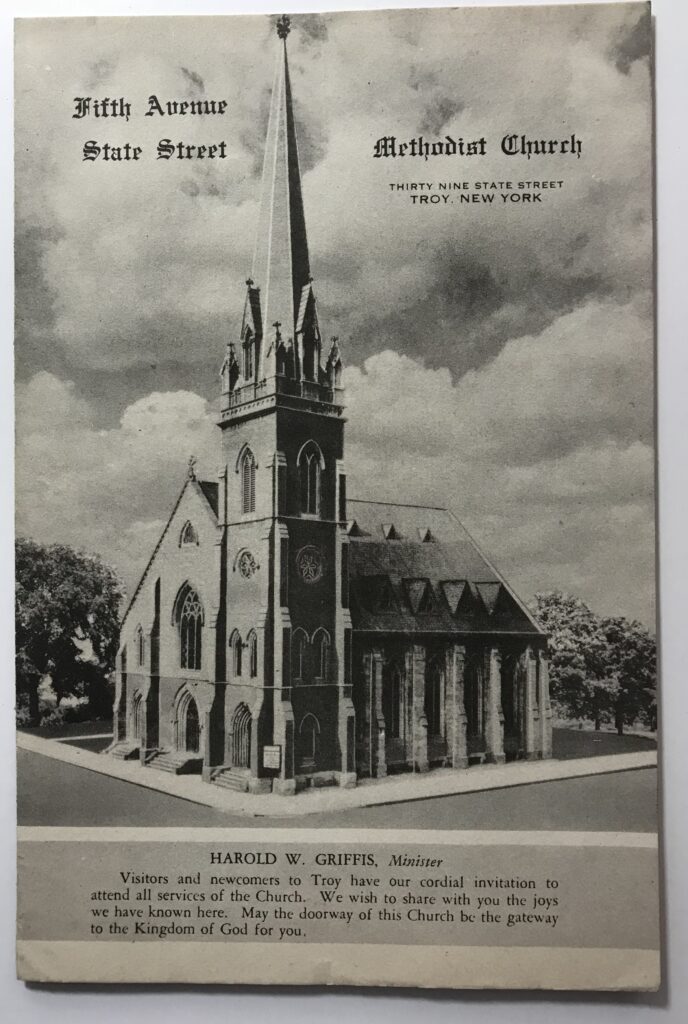
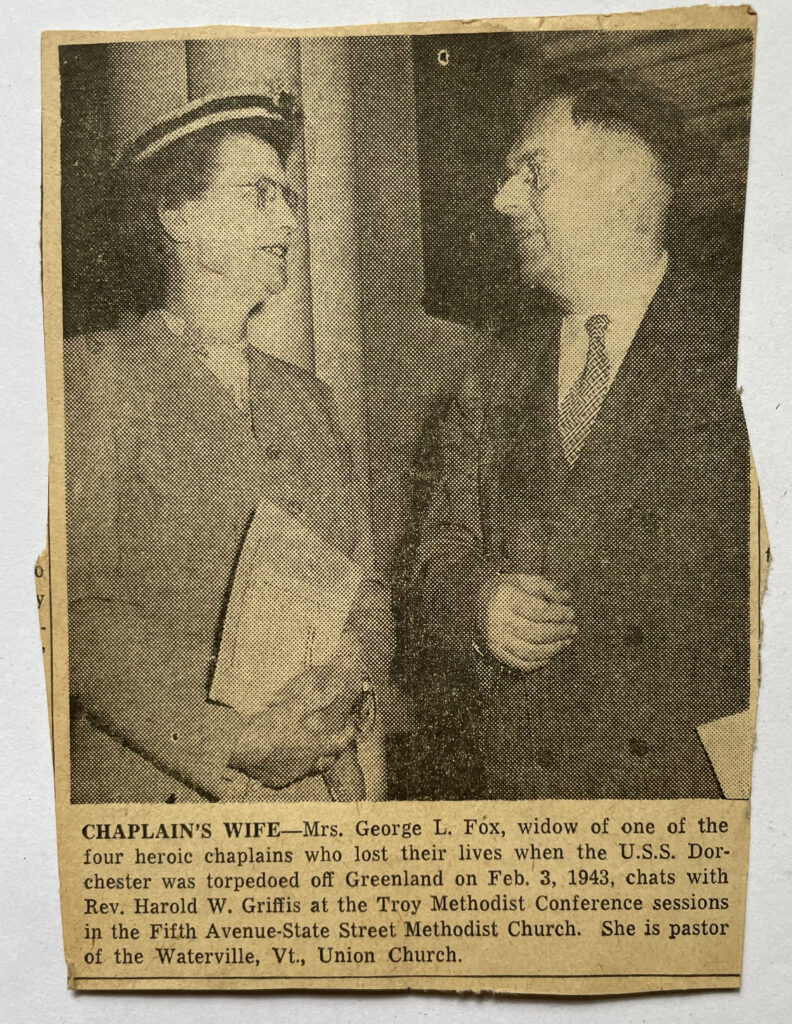
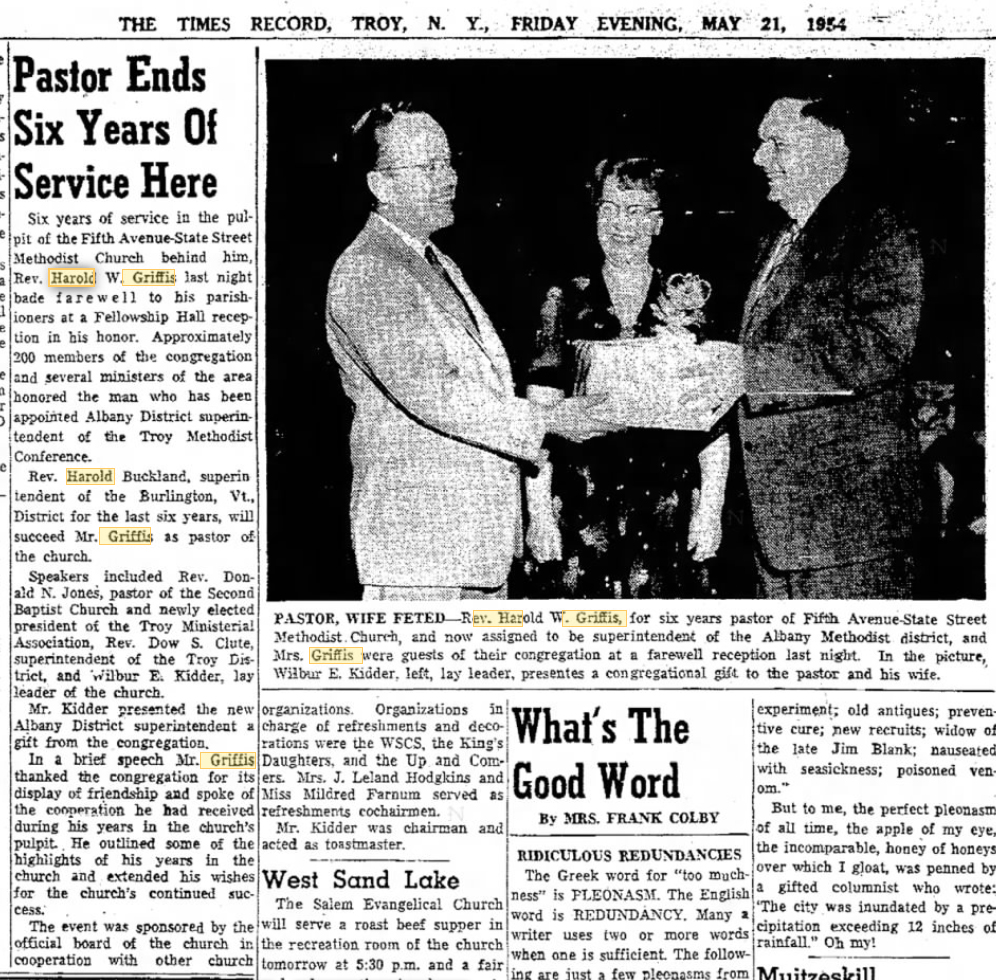
1954 -1958: District Superintendent of the Albany NY district
In 1954, Bishop Frederick Newell appointed Harold as District Superintendent of the Albany District. The parsonage was on Van Rensselaer Boulevard, Albany, New York. His office was in the Trinity Methodist Church on the corner of Lark and Lancaster.
“Trinity Church’s current name and location date back to 1867. Yet the history of the congregation extends much further—to the first Methodist preaching in Albany by Captain Thomas Webb in 1765. Since the establishment of the First Methodist society in 1789, our congregation has had more than ten different homes. The many buildings that have housed Trinity demonstrate that the church is not just a place but a vibrant community that is committed to each other and to the spirit we share.”
“That commitment was tested in 1901 and again in 1931, when Trinity suffered devastating fires. Both times, the congregation chose to stay together and rebuild. The current building, completed in 1933, contains several references to the church’s past, including stained glass depictions of Methodist history and wood carvings that represent our historical ties with Beth Emeth Temple and other area congregations.” [3]
The following series of photographs of the Trinity M.E. Church on Lark and Lancaster Streets were from a commemorative Services of Dedcation booklet who the new church was dedicated in 1933. [4]
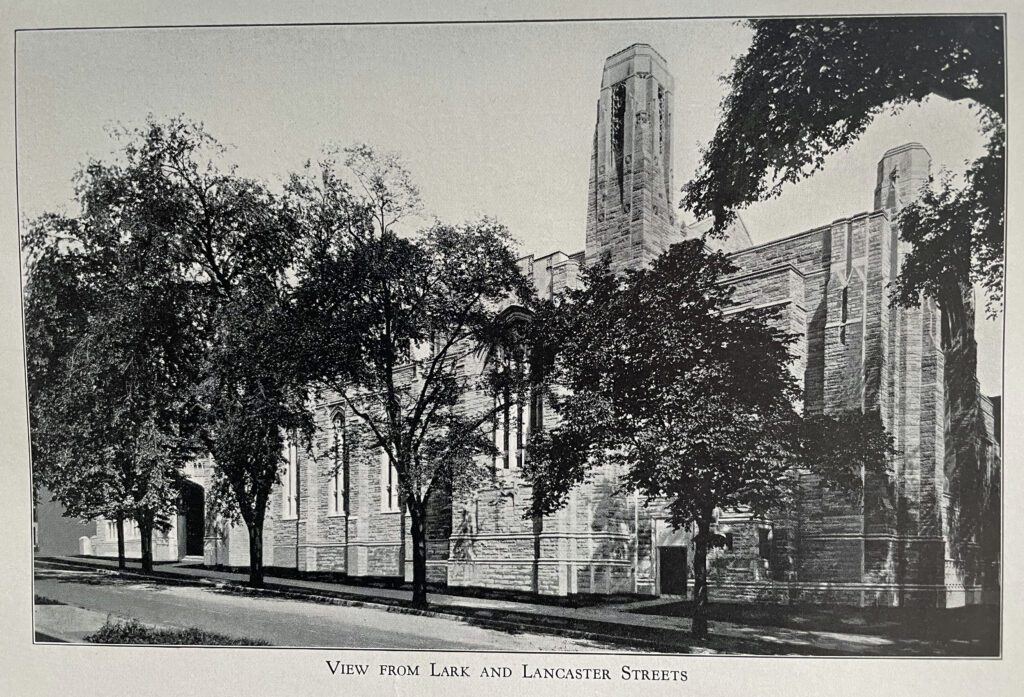
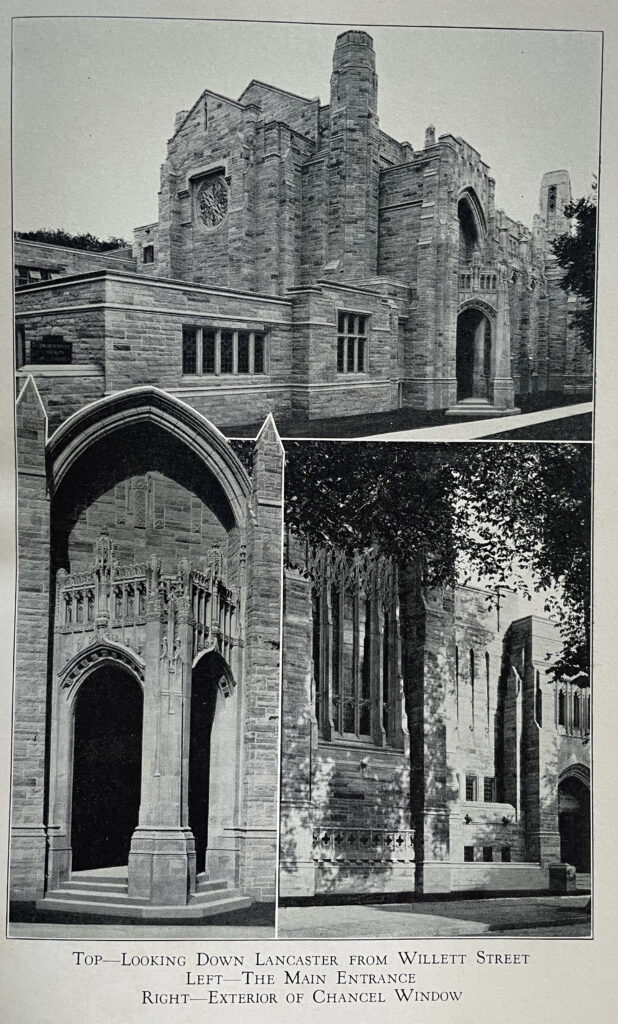
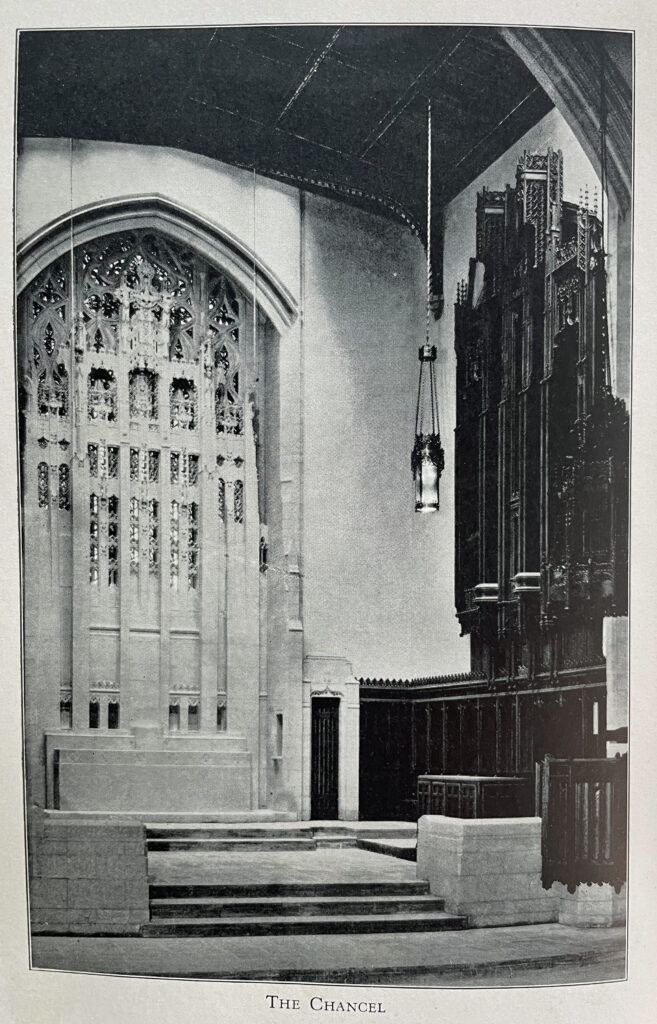
1958: Pastor at Trinity Methodist Church, Albany, NY
After four years as Albany District Superintendent, the Pastoral Relations Committee of the 5th Avenue State Street Methodist Church requested Bishop Oxman to appoint Harold Griffis as their pastor. Harold agreed and the family was in Albany for the remainder of his career.
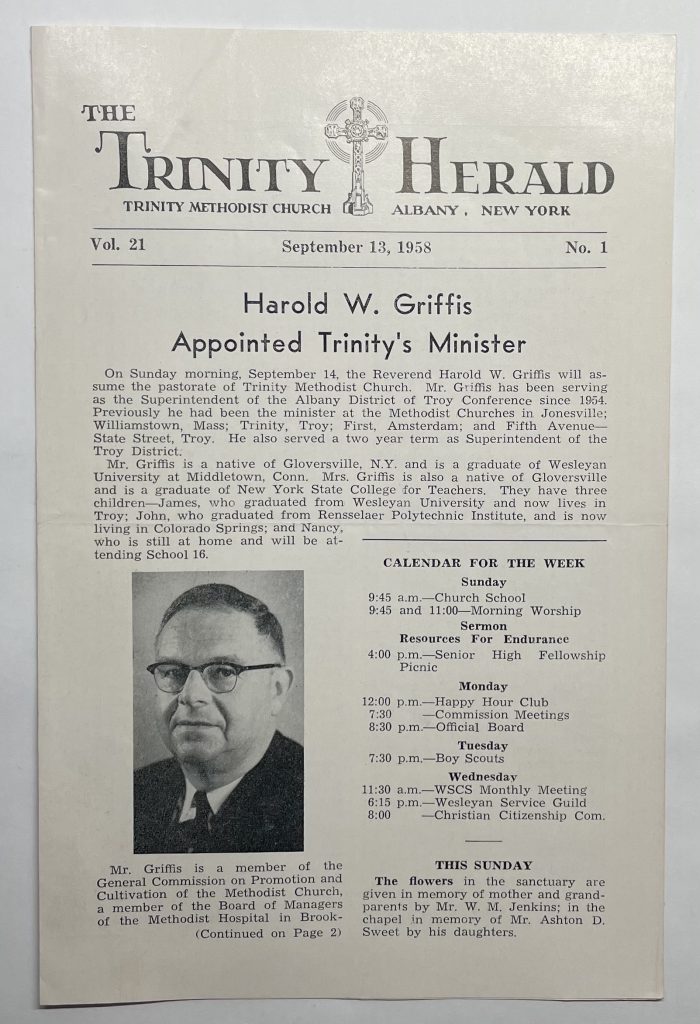

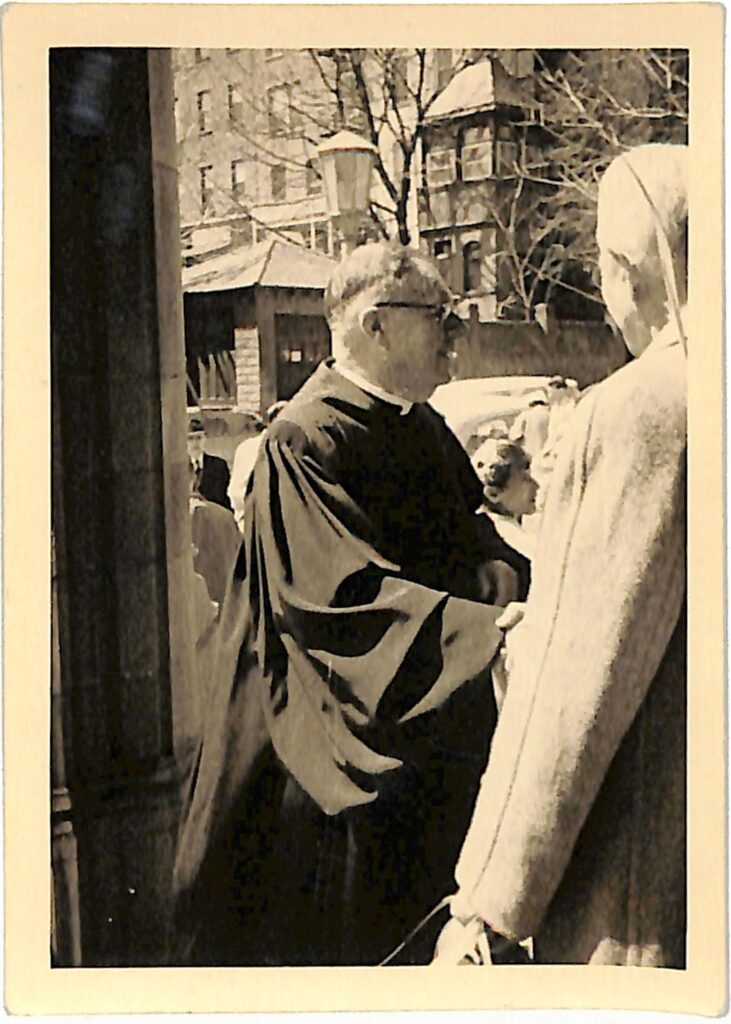
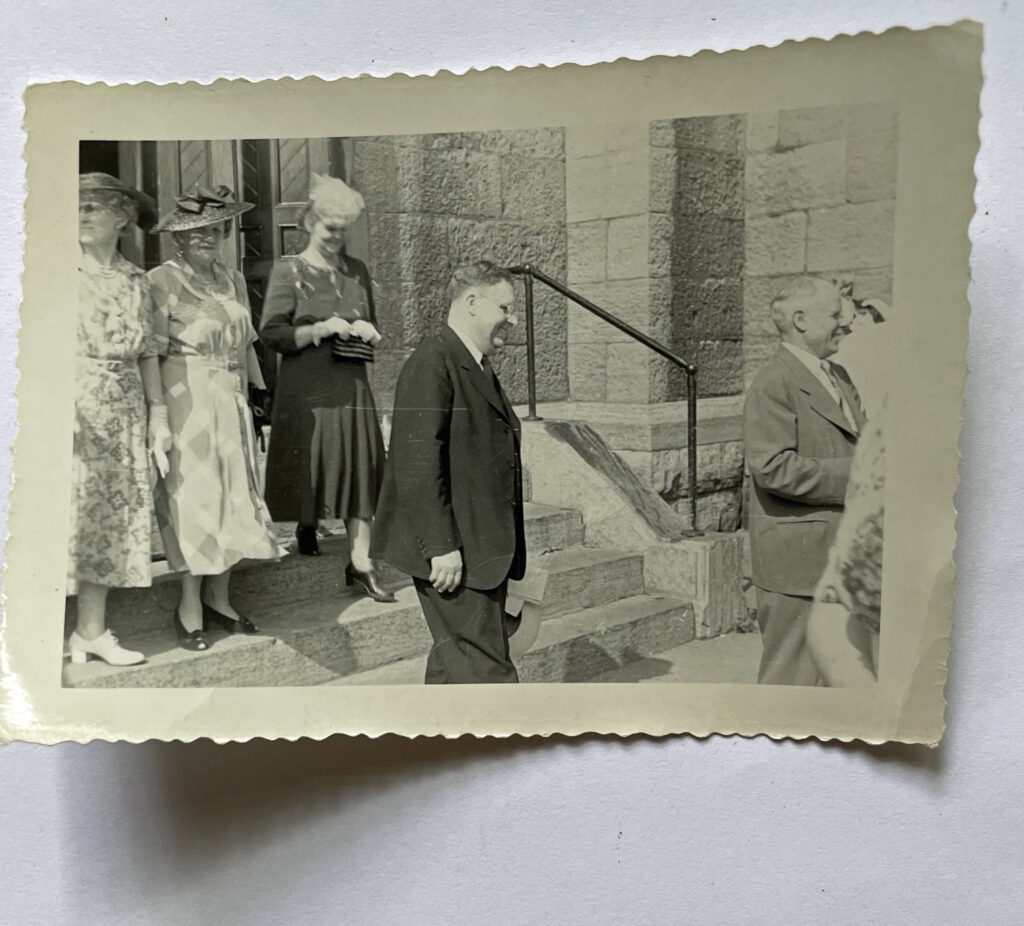
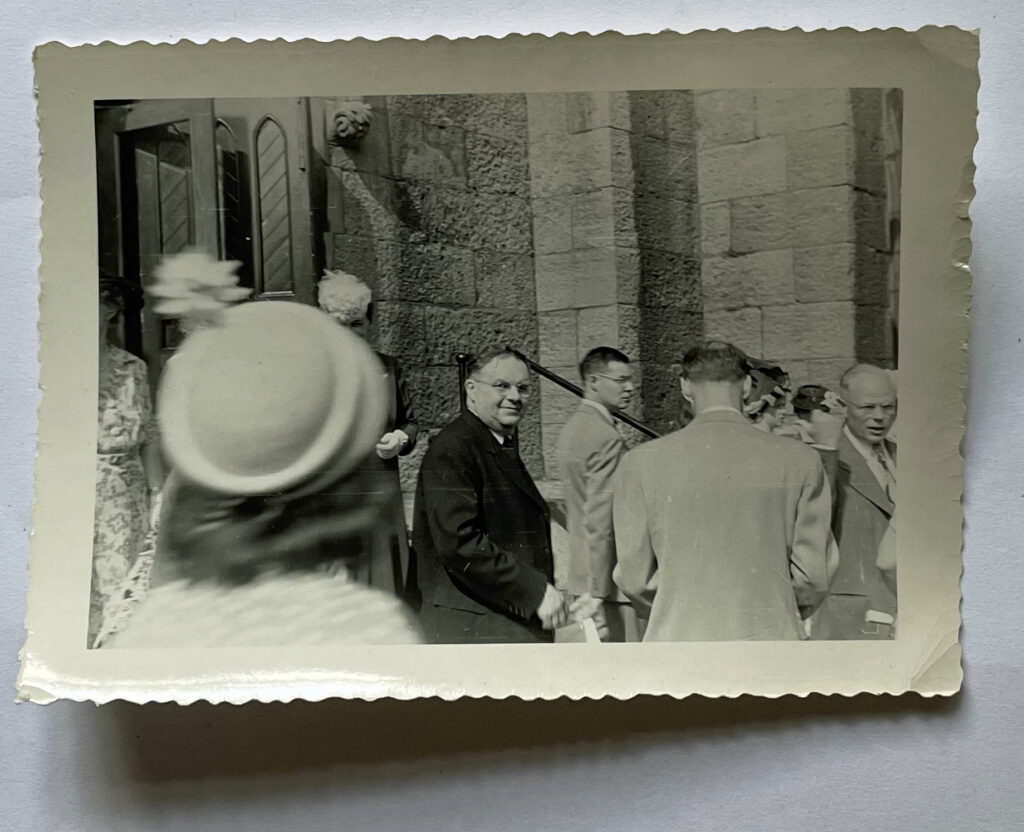
Harold discussing religious matters with one of the many speakers he brought to the church.

In Search of Motivational Speakers
Throughout his career as a pastor, minister and local leader in the business community, Harold Griffis brought notable as well as controversial figures to speak at various occasions. For example, he had Norman Thomas (November 20, 1884 – December 19, 1968), an American Presbyterian minister who achieved fame as a socialist, pacifist, and six-time presidential candidate for the Socialist Party of America. [5]
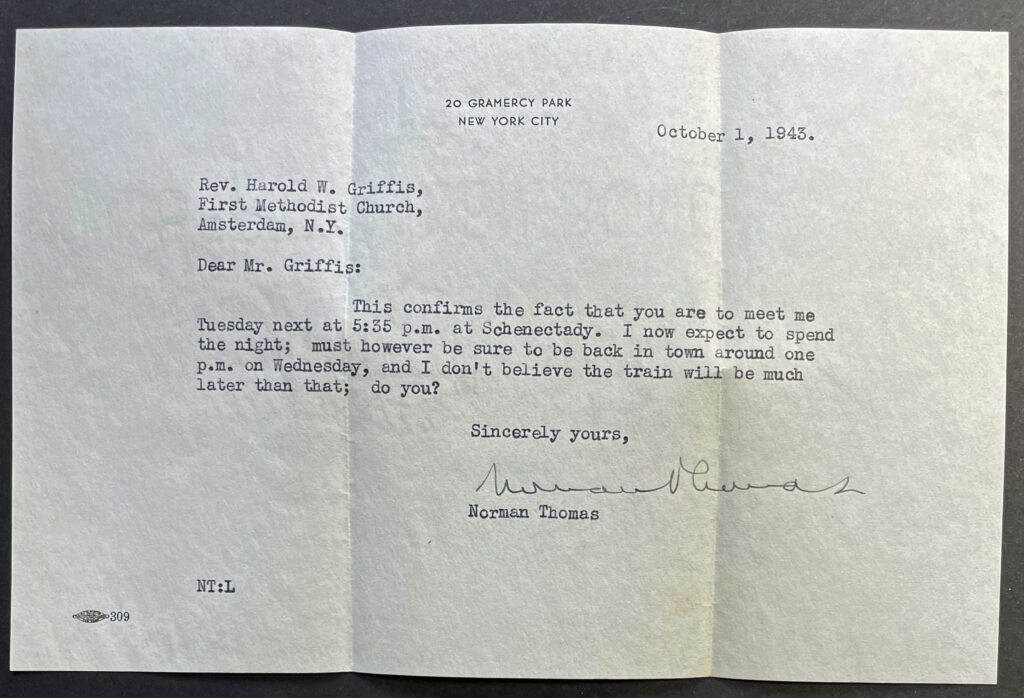
One another occasion, Harold attempted to have Eddie Rickenbacker speak at the Amsterdam Community Forum. Edward Vernon Rickenbacker was an American fighter ace in World War I and a Medal of Honor recipient. With 26 aerial victories, he was the United States’ most successful fighter ace in the war and is considered to have received the most awards for valor by an American during the war. [6]
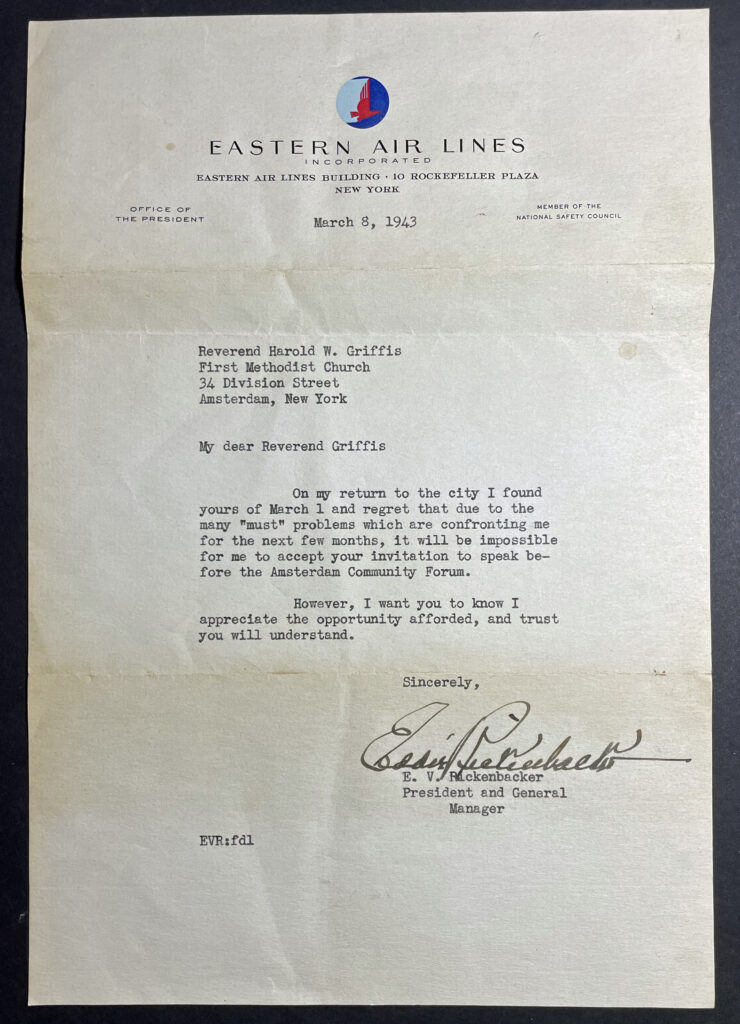

As superintendent of the Albany District, Harold hosted Bishop Newells on part of his circuit speaking engagement regarding his overseas relief efforts.
The Glens FallsTimes October 22 1954 Page 3. Click for larger view.
Harold’s Legacy
In 1961, Harold suffered a stroke and died the day after his birthday, June 30, 1961. He was buried in the family plot at Ferndale Cemetery, Johnstown, New York June 2, 1961.

Around the Thanksgiving holiday in 1961, a memorial service was held and a plaque dedicated to Harold Griffis was placed in the Fifth Avenue State Street Trinity Methodist Church in Troy, New York. The plaque can still be found in the hallway of the church. [7]
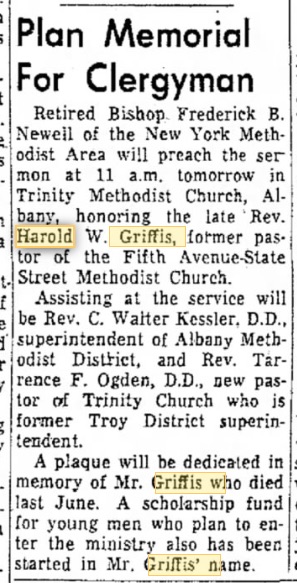
A Harold W. Griffis Memorial Fund for scholarships for students at the newly established Alaska Methodist University was started at the same time. The goal was to establish a $25,000 fund for student loans. Six local area Methodists churches were part of he fundraising committee. Below is the pamphlet presentation on the Memorial Fund, November 1961.

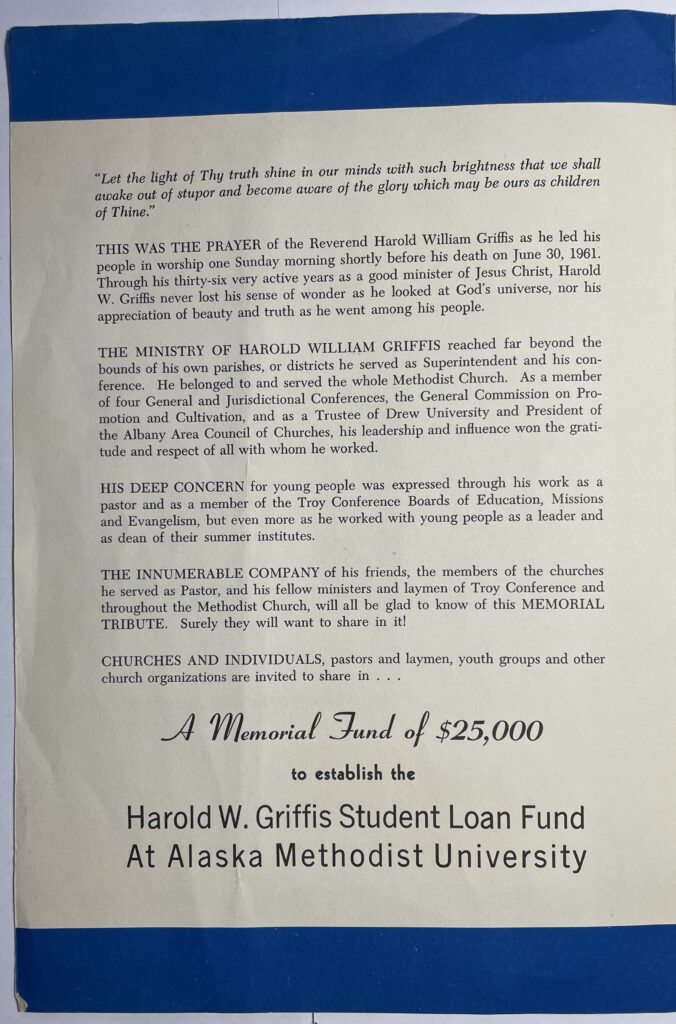
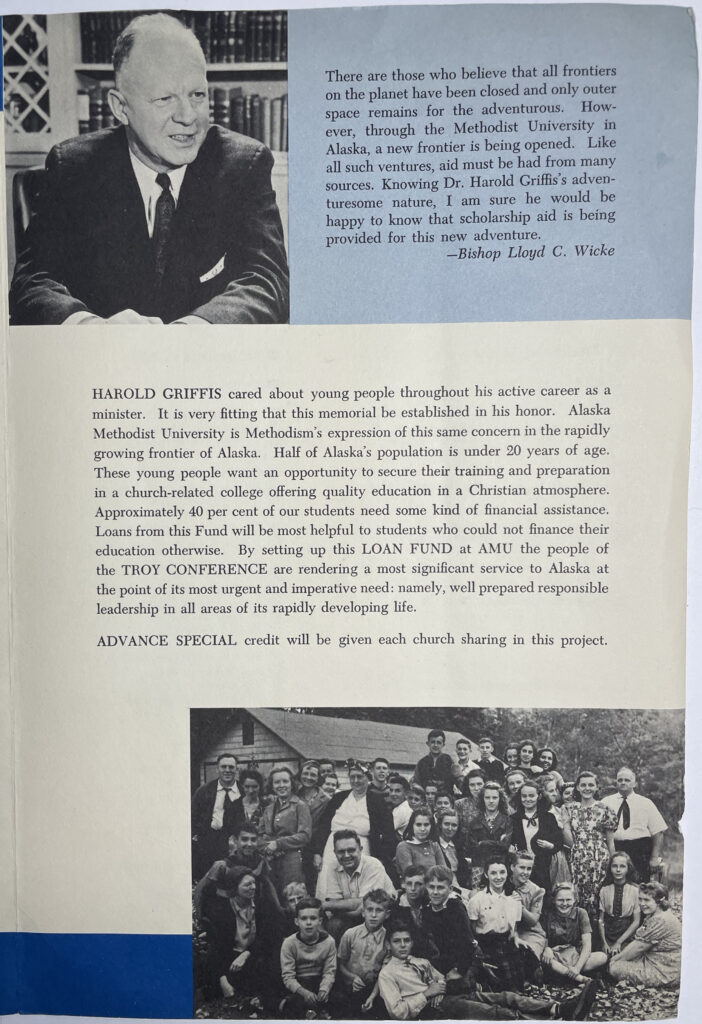
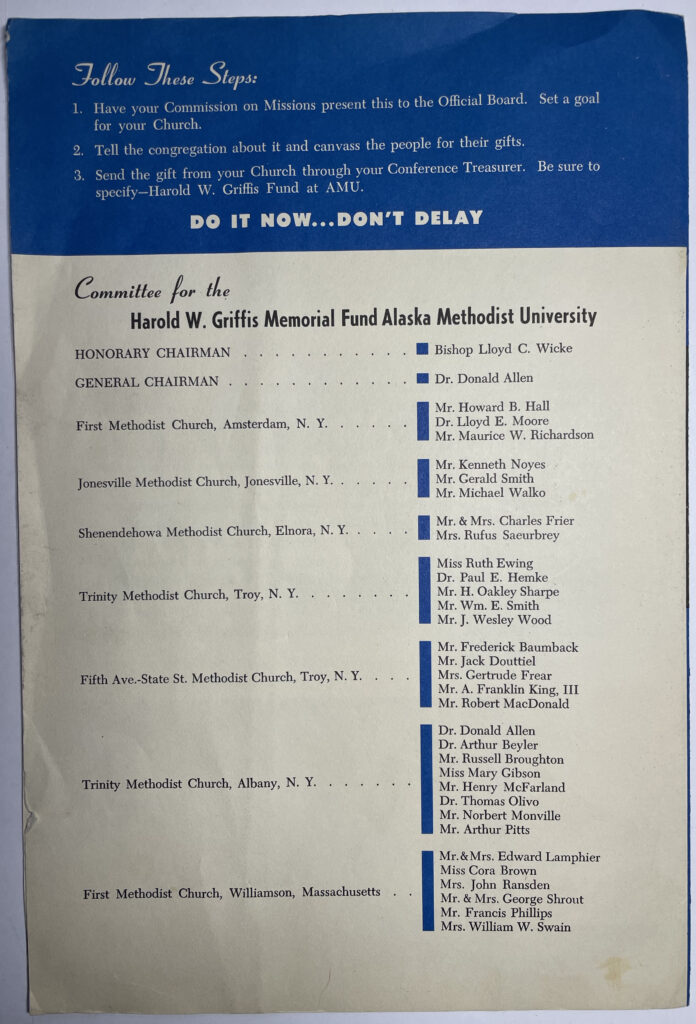
Alaska Methodist University was a newly established university when Harold died. During the 1952-1956, the Quadrennium of the Methodist Church determined developmental phases of establishing an Alaska university.
Alaska Methodist University (in 1978 it became the Alaska Pacific University) is located on what originally was used as Da’naina Indian land for a subsistence. Efforts began as early as 1952 to establish a Methodist University. Eleven communities offered sites for the college. Anchorage was chosen for the location for the University. Citizens of Anchorage purchased a 242 acre site from the Federal government in 1955 and presented the gift to the Division of National Missions of the Methodist Church.
A dedication for the campus of Alaska Methodist University was held June 29, 1958 (which incidentally was Harold’s birthday) in Anchorage, just one day before statehood celebrations (on June 30, 1958 the United States Senate passed the Alaska Statehood bill by a vote of 64-20). The doors opened at Alaska Methodist University on Friday, September 30, 1960 and classes started October 3, 1960. [8]
Sources
Featured Image at top of story: The photograph is a blow up of a portion of a small photograph with the following inscription on back: “Just an “Hello” from us after church one Sunday morning. Our prayers and best wishes are with you wherever you go.” – “Your Home Church Folks”, click for larger of the blow up portion of the photograph. The photograph and inscription on the back reflects the positive influence that Harold and Evelyn had on parishioners, wherever they landed based on the decisions fo the local Bishops of the Methodist Church.
This story is partly based on material from a book originally published on the life of Harold Griffis as a Methodist minister, see James F. Griffis (Ed.), Sermons, Notes and Letters of Harold William Griffis, Self published, Blurb: Oct, 2018
[1] Cudmore, Bob, Reporter Donlon preserved Amsterdam history, June 14, 2014, The Daily Gazette, page accessed August 2, 2021.[
2] Hillman, Joseph, The History of Methodism in Troy, N.Y. NewYork: Moss Engraving Company, 1888, Page 58-82
[3] History of Trinity United Methodist Church, website, accessed 8 Jun 2021
[4] Services of Dedication, Trinity Methodist Episcopal Church, Albany, New York, September 17, 1933, 38 page booklet on the dedication of the new church building.
[5] Norman Thomas, Wikipedia, Page updated 21 Mar 2021, page accessed 22 Apr 2021.
[6] Eddie Rickenbacker, Wikipedia, Page updated 20 Apr 2021 page accessed 23 Apr, 2021.
[7] The Times Record, Troy, New York, November 25, 1961
[8] Larry Hayden, History of Alaska Methodist University 1948 – 1977 Alaska Pacific University 1978 – 2008, April 2008 The Alaska Conference A Missionary Conference of The United Methodist Church
Cudmore, Bob, Reporter Donlon preserved Amsterdam History Daily Gazette, June 2014. https://dailygazette.com/2014/06/14/reporter-donlon-preserved-amsterdam-history/



